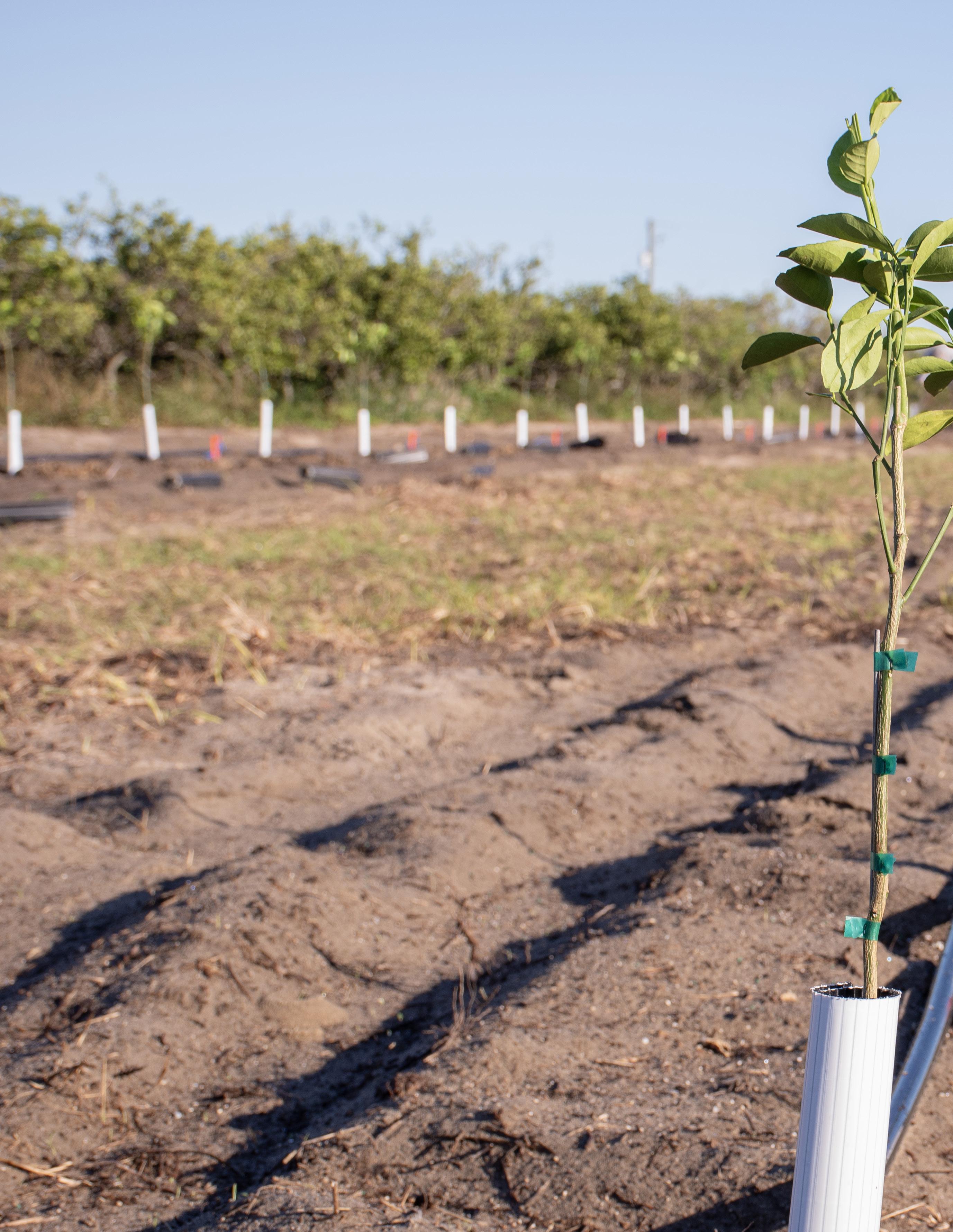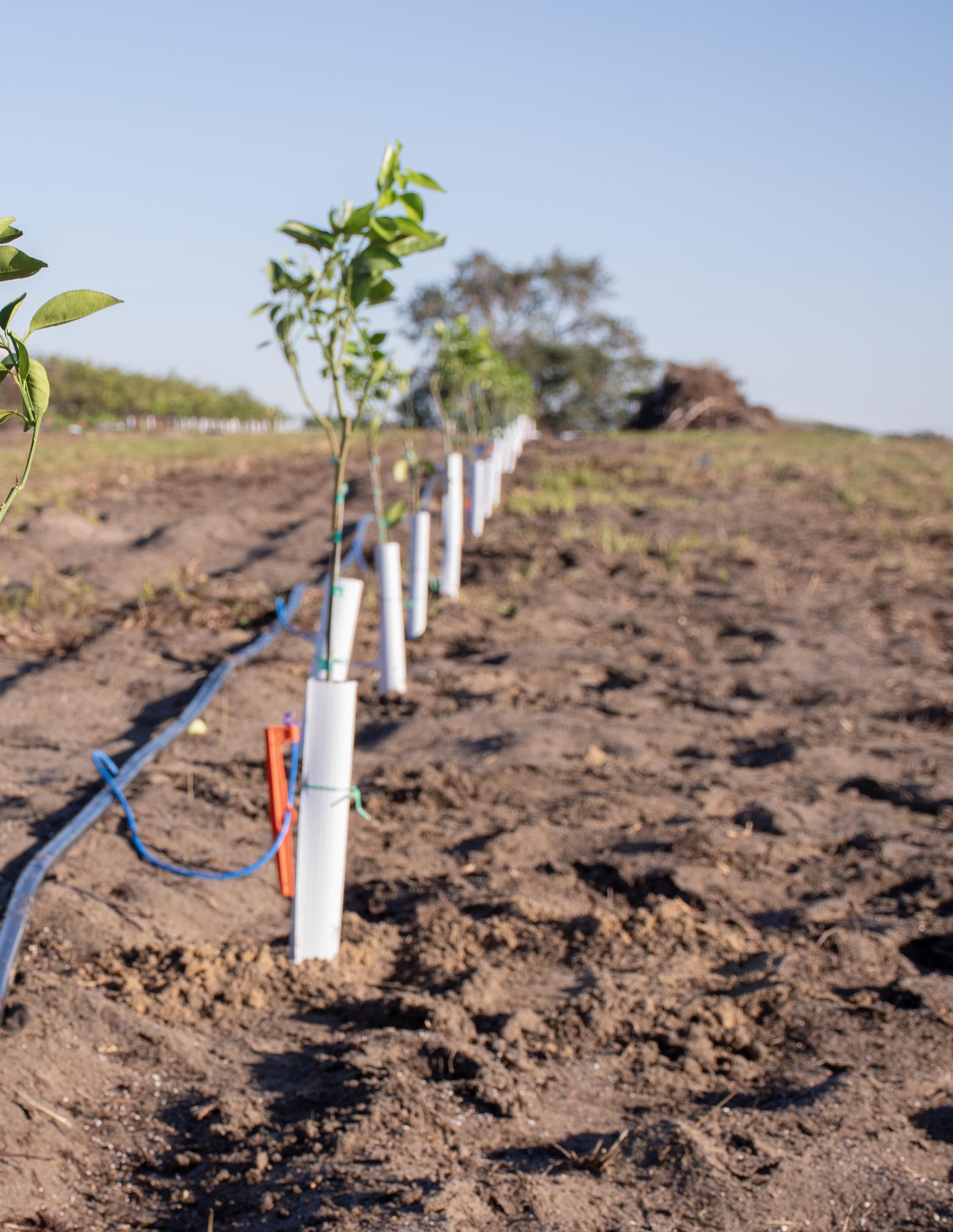

Keeping Florida Citrus Growers
Information about ongoing UF/IFAS citrus research projects that provide tools for the Florida citrus industry.
Table of Contents
Understand and Identify Huanglongbing Tolerance in Citrus and its Relatives 4
Early-season Sweet Oranges and Grapefruit with Improved Tolerance to Huanglongbing ....................................................... 5
Utilizing the Huanglongbing (HLB) Tolerance Traits in Citrus Relatives to Build Better HLB Tolerant Rootstocks 6
Progress in Improving Citrus Resistance Against Huanglongbing via CRISPR Genome Editing .............................. 7 Biotechnological
10 Modulating the Anthocyanin Pathway to Develop Improved Sweet Oranges ......................................................... 11 New Scion Releases Restore NFC Juice Quality in the Battle against Huanglongbing 12 New Scion and Rootstock Releases Offer Hope in the Battle against Huanglongbing 13
Can Finger Limes Help ‘Valencia’ Trees be More Tolerant of Huanglongbing? ..................................................................... 14
UF SunLime and UF RedLime: Two New Finger Lime Cultivars for the Specialty Citrus Market 15 Make Transgenic Citrus Lines with Robust Huanglongbing Tolerance ................................................................................... 16
Citrus Tristeza Virus (CTV) Expressed Antimicrobial Peptides Induce Tolerance to Huanglongbing 17
CTV-T36 Vectors as a Tool to Induce Efficient Flowering in Citrus Seedlings ......................................................................... 18
Using Citrus Tristeza Virus to Dissect Plant Response to Identify Citrus Targets for CRISPR Modification 19
Optimal Combination of
This publication contains brief summaries of current research being led by UF/IFAS citrus scientists located at UF/IFAS research centers in Gainesville, the Citrus Research and Education Center in Lake Alfred, the Southwest Florida Research and Education Center in Immokalee, the Indian River Research and Education Center in Fort Pierce, and the North Florida Research and Education Center in Quincy. This research advances our knowledge about growing citrus in Florida including fighting HLB, improved grove management, and better nutrition recommendations. While definitive recommendations and findings are still in development, these updates provide insights into our ongoing progress. Please contact the faculty listed with each summary for more information or to discuss their research. More resources are available online at citrusresearch.ifas.ufl.edu
Understand and Identify Huanglongbing Tolerance in Citrus and its Relatives
Researchers:
Ozgur Batuman, Choaa El Mohtar, Amit Levy, Zhonglin Mou, Danelle K. Seymour
Contact: Ozgur Batuman, UF/IFAS SWFREC obatuman@ufl.edu
Summary:
All elite commercial citrus cultivars are susceptible to huanglongbing (HLB). However, wild relatives of citrus (such as Australian lime) tolerate HLB. One mechanism of HLB tolerance is reducing callose and reactive oxygen species (ROS) accumulation when infected with C Las. Therefore, if we understand how citrus relatives regulate callose and ROS upon infection, we can reprogram commercial citrus to respond in a similar manner, enabling tolerance in elite commercial citrus scions. In this project, we will identify citrus accessions with elevated basal callose levels, test their HLB tolerance, and identify genetic markers that will help us identify genetic defects (i.e., elevated callose and ROS accumulation) within commercial citrus, and use this knowledge for breeding purposes. One approach to rapidly introducing HLB resistance
Funding:
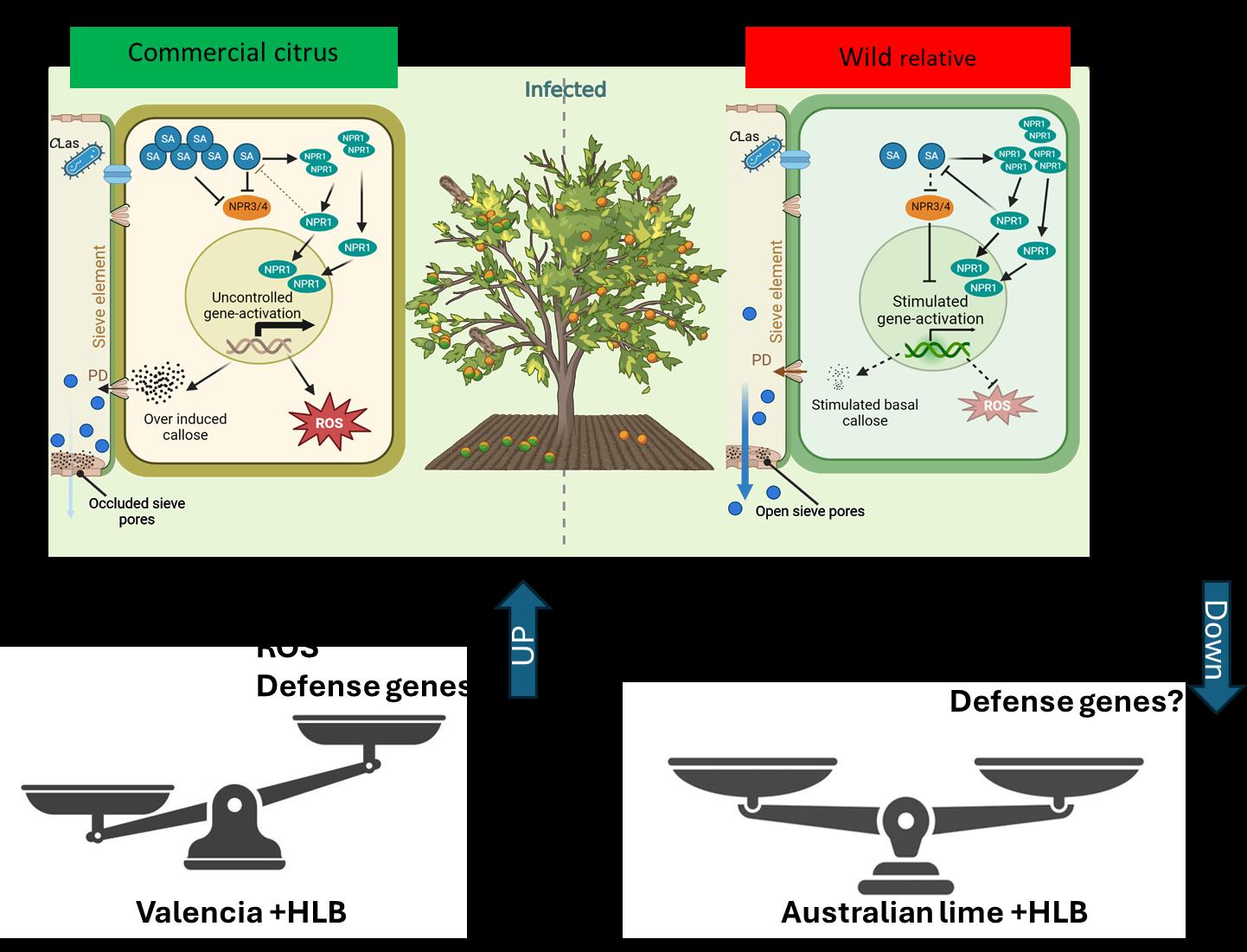
in our cultivars is using transgenic or transient expression approaches. We will use citrus tristeza viral vector (CTV) or transgenic approaches to overexpress or downregulate citrus defense genes, or combine them to make ‘Valencia’ or ‘Hamlin’ tolerant/ resistant like wild citrus and some relatives. The outcome of this project will allow us to: 1) understand better the molecular mechanisms underlying HLB susceptibility and tolerance, 2) obtain new citrus germplasms with reduced C Las-induced callose and ROS accumulation, 3) acquire potential biomarkers for conventional breeding, 4) identify citrus genes involved in defense mechanism and manipulate them with gene editing or balanced expression approaches for HLB resistance, and 5) better understand the citrus immune system leading to HLB susceptibility and tolerance.
Take Home Message:
• We will learn the regulations of citrus defense-related genes involved in HLB tolerance/resistance in citrus relatives.
• We will utilize gene expression and gene-editing strategies to decrease our cultivars’ susceptibility to HLB.
• Knowledge gained will allow us to increase HLB tolerance in both scion and rootstock citrus varieties.
Early-season Sweet Oranges and Grapefruit with Improved Tolerance to Huanglongbing
Researchers:
Manjul Dutt, Gary England, Sheetal Ramekar
Contact: Manjul Dutt, UF/IFAS CREC manjul@ufl.edu

Summary:
We have recently identified several early-season selections that better tolerate huanglongbing (HLB) than other earlies. This project has led to the Citrus Research and Field Trial (CRAFT) Foundation recommendations of two selections: R20-T30 (a ‘Parson Brown’ type) and R21-T36 (a ‘Hamlin’ type), and they are available for evaluation by the stakeholders. A new ‘Flame’ grapefruit-derived bud sport that better tolerates HLB has also been identified. Named the Lennon Flame, the bud sport produces later maturing fruit
(2-3 weeks later than the parent) and is notably healthier, with lush green leaves and better fruit quality. This selection is also available in the Division of Plant Industry (DPI) repository for propagation. Some selections sourced from the Carney Orange 3 are currently being evaluated in the field, and several are showing healthy growth with very low HLB titers. These selections are being grown without any IPC covers to assess their response to HLB in these young trees. A few of these selections are also being propagated for more extensive replicated field evaluations to confirm our preliminary observations.
Take Home Message:
• Newer selections have enhanced tolerance to HLB and are being propagated for multi-location field trials to confirm HLB tolerance.
Funding:

Utilizing the Huanglongbing (HLB) Tolerance Traits in Citrus Relatives to Build Better HLB
Tolerant
Rootstocks
Researchers: Manjul Dutt, Nabil Killiny, Jude Grosser, John Chater, Lamiaa Mahmoud
Contact: Manjul Dutt, UF/IFAS CREC manjul@ufl.edu
Summary:
Several citrus species have enhanced tolerance to huanglongbing (HLB). Some like the Australian lime species (Citrus australasica, C. australis, and C. glauca) are resistant to HLB. Others, such as the C. latipes, have been observed to be highly tolerant of HLB. Our breeding focus has been to utilize the natural tolerance/resistance traits of these species to develop hybrids of HLB-tolerant rootstocks that can better endure HLB and support citrus scions. Hybrids developed with these species and select UF germplasm have demonstrated enhanced tolerance to HLB in preliminary greenhouse studies and limited field evaluations.
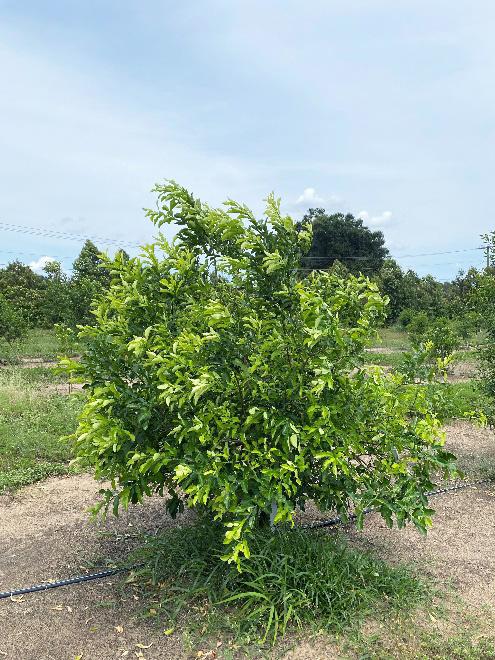
Some hybrids have remained HLB negative as rootstocks even after years of field evaluations. Currently, a select population of these hybrids is being clonally propagated for extensive multi-location field trials. By carefully selecting and breeding citrus varieties with natural HLB tolerance traits, leveraging modern genomic techniques, and conducting thorough field trials, we can develop rootstocks that help citrus trees endure the stresses caused by HLB. Over time, these improved rootstocks could become a crucial component of an integrated strategy to combat HLB and ensure the sustainability of citrus production globally.
Take Home Message:
• HLB-tolerant rootstocks can be produced by breeding with HLBtolerant citrus relatives.
• Several new rootstocks have demonstrated enhanced tolerance to HLB.
Funding:
Progress in Improving Citrus Resistance Against Huanglongbing via CRISPR Genome Editing
Researchers: Nian Wang, Jude Grosser, Ahmad Omar
Contact:
Nian Wang, UF/IFAS CREC
nianwang@ufl.edu

Summary:
In a recent study, we have identified multiple genes that are required for Candidatus Liberibacter (C Las) triggered immune disease development. CRISPR genome editing technology has been employed to generate over 200 genome edited lines by targeting those genes. Importantly, the non-transgenic genome edited lines for the two top target genes (Eds1 and Dmr6) have received regulatory approvals by both USDA-APHIS and EPA. The non-transgenic genome edited Eds1 (Valencia Super UF W1 and Hamlin Super UF W3) and Dmr6 (Valencia Super UF W2 and Hamlin Super UF W4) citrus trees were provided to the DPI New Budwood Program on July 15, 2025. The non-transgenic Eds1
edited ‘Valencia’ and ‘Hamlin’ are likely tolerant to HLB. Using the HLB pathogen relative which infects tomato, we have found that huanglongbing (HLB) pathogen relative triggers induction of ROS production, and phloem callose deposition through the Eds1 pathway. Knockout of Eds1 abolished the disease symptoms of tomato caused by the HLB pathogen relative. The non-transgenic Dmr6 edited ‘Valencia’ and ‘Hamlin’ are likely resistant to HLB by enhancing the killing of the HLB pathogen. Knockout of Dmr6 is known to increase the level of salicylic acid in response to pathogen infection and increase disease resistance against bacterial, fungal, and oomycete pathogens in many tested crops. It is one of the broadest disease susceptibility gene required for
pathogen growth. The Eds1 and Dmr6 edited plants were inoculated with C Las for disease resistance evaluation. Further evaluation of those nontransgenic genome edited lines in field trials are needed.
Take Home Message:
• We have found the genetic evidence for HLB being Candidatus Liberibacter triggered immune disease and those genes are suitable targets for genome editing to improve citrus resistance/ tolerance against HLB.
• The non-transgenic Eds1 and Dmr6 edited lines have received regulatory approvals.
Funding:
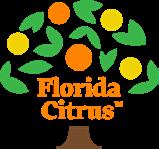




Biotechnological Methods for Building a Better Citrus
Researchers: Manjul Dutt, Jude Grosser
Contact:
Manjul Dutt, UF/IFAS CREC
manjul@ufl.edu
Summary:
The primary objective of this project is to develop solutions that can be rapidly implemented to enhance citrus improvement strategies aimed at combating huanglongbing (HLB). While conventional breeding for resistance remains an ideal long-term goal, fostering tolerance, where citrus plants can survive and produce fruit in HLB-endemic regions, may offer a more immediately practical path. The current project utilizes molecular methods that enable citrus trees to mount an effective defense against HLB by enhancing the plant’s natural immune response, specifically through genetic engineering or genome editing

of both scions and rootstocks to boost systemic acquired resistance (SAR)-a plant defense system akin to innate immunity in animals, triggered through the activation of key defenserelated genes. In the short term, this project aims to generate populations with increased HLB tolerance. By its conclusion, multiple populations of genetically engineered citrus will have been developed and assessed for their resilience to HLB. Additionally, engineered rootstocks capable of protecting non-engineered scions from HLB will be developed, field tested, and presented for regulatory approval and real-world testing by industry stakeholders.
Take Home Message:
• HLB-tolerant scions and rootstock can be produced by utilizing genome editing or transgenics.
• Field trials will confirm if SAR is a valid strategy for HLB tolerance.
Funding:
Cybridization for Plant Improvement
Researchers: Ahmad A. Omar, Fred Gmitter, Christine Chase, Mayara Murata, Jim Graham, Flavia Tabay
Zambon, Jude Grosser
Contact: Ahmad A. Omar, UF/IFAS CREC
omar71@ufl.edu
Summary:
To determine whether cytoplasmic components from canker-resistant ‘Meiwa’ kumquat could improve disease tolerance in grapefruit, we created 144 cybrids via protoplast fusion using ‘Flame’, N11-11 Ruby somaclone, and ‘White Marsh’ grapefruit. All cybrids maintained grapefruit morphology and inherited mitochondrial genomes from ‘Meiwa’. Chloroplast inheritance was biased toward kumquat, with 125 cybrids carrying kumquat chloroplasts and 19 retaining those of grapefruit. Canker tolerance, evaluated through attached leaf assays, remained low in cybrids with grapefruit chloroplasts but was significantly improved in many cybrids with kumquat chloroplasts. The cybrids were field-planted at UF/IFAS IRREC, Fort Pierce, under high disease pressure. Most trees declined due to
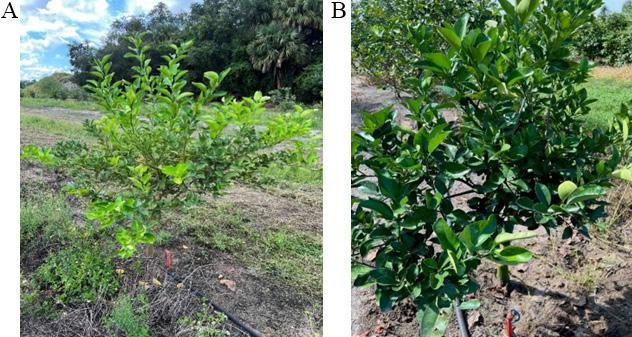
huanglongbing (HLB) symptoms and herbicide damage, with only a few survivors after two years. These were grafted onto UFR-1 rootstock and moved to a high-salinity commercial grove, where most continued to decline. However, one standout - Cybrid #3, derived from N11-11 and bearing kumquat chloroplasts, remained vigorous and symptom-free for both canker and HLB. Cybrid #3 was propagated onto UFR-5 rootstock. qPCR testing of 19 clones detected no Candidatus Liberibacter asiaticus (C Las) bacteria (Ct = 40), suggesting possible HLB tolerance. A new trial population is under evaluation in Fort Pierce, with growth data collection in progress. Fruiting potential and performance are also being assessed, with topworking underway at UF/IFAS CREC, Lake Alfred, to accelerate testing.
Take Home Message:
• Cybrids with kumquat chloroplasts showed improved canker tolerance compared to those with grapefruit chloroplasts.
• Cybrid #3 exhibited no symptoms of citrus canker or HLB, even under high disease pressure and environmental stress.
• qPCR analysis of Cybrid #3 progeny revealed no C Las infection, suggesting potential HLB tolerance. Validation is underway.
Funding:

A) Ruby somaclone N11-11 Cybrid #3 tree impacted by saline irrigation water and B) transplanted Cybrid #3 tree to location irrigated with well water.
The Importance of Long-term Variety TrialsThe Millennium Block
Researchers: Flavia Tabay Zambon
Contact: Flavia Tabay Zambon, UF/IFAS IRREC
f.zambon@ufl.edu
Summary:
Established in 2019-20 the robust Millennium Block presents a look at the requirement of patience and consistent funding for large variety trials. In the 20 acres, 5,500 trees are divided in four independent trials: trial 1 comprised of 18 scions and 3 rootstocks, a total of 54 combinations. Trials 2, 3, and 4 are rootstock trials where 31 rootstocks are grafted onto ‘Ray Ruby’ grapefruit, ‘Glen’ Navel and ‘UF-950’ mandarin. For the past three seasons, ‘UF 914’ has had consistently higher °Brix and requires canopy management to sustain the cluster of heavy fruits. A fortuitous finding is ‘Triumph’, one of the oldest Florida grapefruit, yielding over 200 boxes per acre (at 227 trees/acre) in 2023-24. In the 2024-25 season,
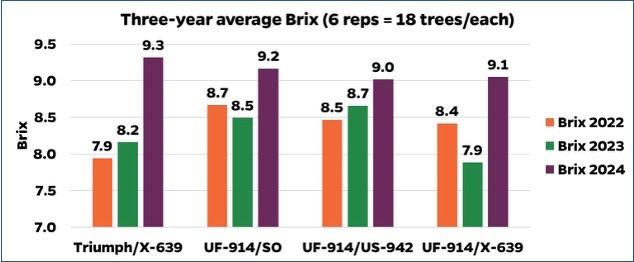
however, Triumph only produced around 90 boxes, with the same fruit quality as the previous season. The excellent juice quality and golden flesh are key to returning this variety to the market. ‘Ray Ruby’ grafted onto ‘UFR-15’ has shown the highest yield among the 32 rootstocks tested, while a new rootstock, 2247 x 6070-02-2, and ‘UFR-11’ yielded the highest °Brix in 2023-24 and 2024-25, respectively. Glen Navels are not suitable for the Indian River Region environment, as fruit quality and yield were below industry standards. For the third year in a row, the mandarins never produced a harvestable crop. The trees bloom, set fruit, but none reach maturity. On an important note, no oxytetracycline (OTC) injections have been done at the Millennium Block.
Take Home Message:
• ‘UF-914’ produces good quality fruit despite huanglongbing (HLB).
• ‘Triumph’ grapefruit hybrid opens an opportunity to revisit historical material for HLB tolerance.
• Glen Navels are not suitable for the Indian River Region environment, as fruit quality and yield were below industry standards.
Funding:

Modulating the Anthocyanin Pathway to Develop Improved Sweet Oranges
Researchers: Manjul Dutt, Nabil Killiny, Jude Grosser
Contact: Manjul Dutt, UF/IFAS CREC manjul@ufl.edu
Summary:
Juice from huanglongbing (HLB)affected trees often lacks the bright, consistent color and aroma of juice obtained from healthy HLB-free trees. Enhancing the juice quality through the upregulation of anthocyanins offers numerous benefits, both from a nutritional and commercial standpoint. Anthocyanins, which are natural pigments responsible for red, purple, and blue hues in fruits, are potent antioxidants known to support cardiovascular health, reduce inflammation, and protect against certain chronic diseases. Citrus fruits are generally not known for high levels of anthocyanins, apart from the blood
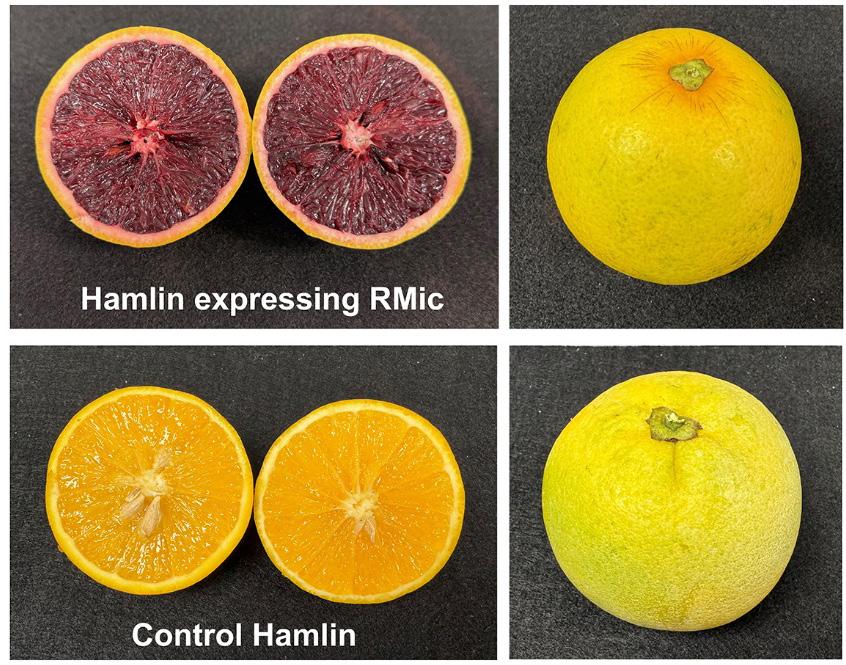
oranges. Although blood oranges can grow in the warm subtropical citrus belt, the characteristic blood color from increased anthocyanin production is not achieved due to the lack of cold stress. Genetic manipulation of regular sweet oranges has resulted in citrus trees that produce enhanced anthocyanins even under central and south-central Florida conditions. Enhanced anthocyanins resulting in a deep red color in the young citrus flushes can also deter psyllids by interfering with their visual cues. Proposed field trials will confirm the potential of these genetically modified trees to survive better under endemic HLB conditions while also producing anthocyanin-rich sweet orange fruit.
Take Home Message:
• Enhanced anthocyanin-rich sweet oranges producing fruits in central and south central Florida have been produced.
• Field trials will confirm the ability of these fruits to remain productive under endemic HLB conditions.
Funding:
New Scion Releases Restore NFC Juice Quality in the Battle against Huanglongbing
Researchers: Jude Grosser, Fred Gmitter, John Chater
Contact: Jude Grosser, UF/IFAS CREC
jgrosser@ufl.edu
Summary:
During the past year, the UF/IFAS CREC Citrus Breeding Team has released 6 new scion selections with potential to improve the quality of Florida NFC juice in the HLB-endemic environment.
Sweet Oranges: New sweet orange releases include late-maturing selections OLL-DC-36 and OLL-DC-3-40. These two HLB-tolerant selections were derived from OLL-8, which is already one of the most HLB-tolerant sweet orange selections available. Another late-maturing selection, Valencia N40-16-7-11, is the most HLBtolerant selection among more than 1000 Valencia somaclones evaluated in our program; thus we are calling it the ‘Last Man Standing’. All 3 of these new late oranges have exceptional fruit/juice quality. We also released
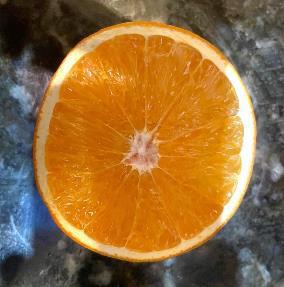

the early-maturing sweet orange somaclone Hamlin N14-10, that was selected for producing juice with higher °Brix and better HLB-tolerance than standard Hamlin.
Blending Hybrids: We released two HLB-tolerant juice blending hybrids, C410-42 and RBA-13-18; both have higher °Brix and better juice color, and good flavor after pasteurization. They have potential to improve our NFC quality when blended at the legal 10%, helping to solve our Brix crisis.
Take Home Message:
• New high-quality processing sweet oranges with improved HLB tolerance have been released, and thus are available for CRAFT-funded projects. Better oranges make better juice!
• Two new highly HLB-tolerant mandarin hybrids with good potential
for blending in NFC at 10% have been released, and are also available. These selections have great potential to improve the brix, flavor and color of Florida NFC juice.
• These new selections will contribute to the ‘Three-legged Stool’ approach for sustainable and profitable citriculture: combining good scion genetics, good rootstock genetics, and enhanced nutrition.
Funding

Orie Lee Family Groves (in-kind)
New Scion and Rootstock Releases Offer Hope in the Battle against Huanglongbing
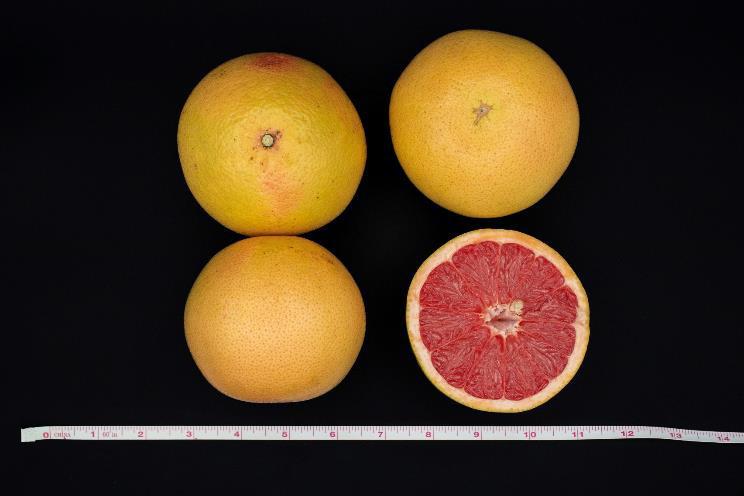
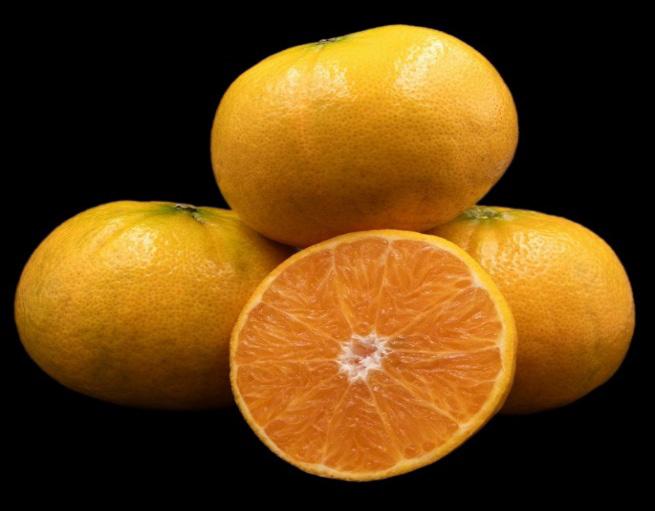
Researchers: Jude Grosser, Fred Gmitter, John Chater
Contact: Jude Grosser, UF/IFAS CREC jgrosser@ufl.edu
Summary:
New releases from the UF/IFAS CREC Citrus Breeding Team.
Grapefruit: We released the dark red grapefruit selection N40-16-11-7, that also shows better HLB-tolerance than other commercial red grapefruit cultivars, with Star Ruby fruit quality. This selection can be grown outside or in CUPS.
CUPS: Another selection released showing promise for CUPS is the nearly seedless Honey Murcott 18A-10-47. This selection produces abundant fruit with superb eating quality.
Dooryard: Two selections with dooryard potential were released. The first is KW-5-7, a cybrid of ‘Dancy’ (the old Florida tangerine) that shows tolerance to Alternaria brown spot, along with better huanglongbing


(HLB) tolerance. The second is a nearly seedless hybrid lime, C4-5-14 ‘Fiestaville’, that produces fragrant, juicy fruit and is slightly larger than ‘Key’ lime. An expanded portfolio of attractive dooryard selections can help our nurseries make it through the difficult HLB bottleneck.
Rootstock: We released one HLBtolerant rootstock Orange 14 (a sibling of UFR-1, 2, and 4). This rootstock has performed well at multiple locations, including one location with high Diaprepes/Phytophthora pressure. It also performed well in a greenhouse screening for sting nematode tolerance. It produces medium-sized trees and is amenable to seed propagation. Combining this rootstock with the more HLB-tolerant sweet oranges above should contribute to the recovery of our juice industry.
Take Home Message:
• Two promising new scions for CUPS, N40-16-11-7 ‘Crimson Queen’ dark red grapefruit and seedless Honey Murcott 18A-10-47 ‘Wow’ are now commercially available.
• Two promising new scions for Dooryard, Alternaria-tolerant Cybrid Dancy KW-5-7 ‘Durable Dancy’ and productive hybrid lime C4-5-14 ‘Fiestaville’ are now commercially available.
• HLB-tolerant rootstock Orange 14, also performing well under high Diaprepes pressure, has been released and is now available (amenable to seed propagation).
Funding:

Orie Lee Family Groves (in-kind)
Can Finger Limes Help ‘Valencia’ Trees be More Tolerant of Huanglongbing?

obatuman@ufl.edu
Summary:
To evaluate the ability of huanglongbing (HLB)-tolerant finger limes to protect susceptible scions such as ‘Valencia’ (and ‘Hamlin’) against HLB, we utilized the interstock grafting technique. The idea is to assess whether antimicrobial peptides (and potentially other molecules) naturally found in finger limes are graft-transmissible and can provide HLB tolerance to citrus tree cultivars grown in Florida. For this, we established numerous ‘Valencia’ plants interstock-grafted with various finger lime types in the greenhouse at the UF/IFAS Southwest Florida Research and Education Center in Immokalee. We challenged these plants with Asian citrus psyllids carrying the HLBcausing bacterium. We determined
that UF-SL and R1T98 interstock grafted scions (‘Valencia’ grafted on finger lime, which was grafted on Swingle rootstock) accumulated HLB bacterium significantly less than regularly grafted scions (‘Valencia’ grafted directly on Swingle rootstock). We are now continuing to monitor the HLB infection rate and the amount of bacteria accumulating in these plants in the grove with monthly visual observations for symptoms and qPCR tests. This study will allow us to better understand the mechanism of HLB tolerance in these graft combinations and to determine whether this method could be another practical tool for the integrated pest management (IPM) strategy for HLB management in citrus groves.
Take Home Message:
• The interstock graft technique may help with transferring HLB tolerance from finger limes to ‘Valencia’ and ‘Hamlin’.
• Preliminary results indicate that interstocked ‘Valencia’ plants protected from HLB and bacterial build up were delayed.
• A similar idea could be achieved by inarching the trees in the grove, and we will be testing this in 2025.
Funding:
Two of the finger lime accessions (UF SL SUNLIME and R1T98) used as interstock significantly delayed CLas infection and slowed the bacterial buildup in the ‘Valencia’ scion.
UF SunLime and UF RedLime: Two New Finger Lime Cultivars for the Specialty Citrus Market

Researchers: Manjul Dutt
Contact: Manjul Dutt, UF/IFAS CREC
manjul@ufl.edu
Summary:
The finger lime is an Australian native citrus that is tolerant to huanglongbing (HLB), and it has been gaining popularity and significance in recent years. This fruit has several unique qualities that distinguish it from conventional sweet oranges and mandarins. The primary characteristic of finger limes is their round to teardrop-shaped juice vesicles, which burst when the fruit is cut. These juice vesicles are commonly referred to as citrus caviar, and they are the main product in commercial trade. The UF/IFAS citrus improvement program has released two improved finger lime
hybrid cultivars for Florida growers to cultivate as specialty crops. The UF SunLime is a finger lime hybrid that produces cylindrical fruit averaging about 3 inches in length. The UF RedLime, on the other hand, is narrow and oblong in shape, tapering slightly at both ends, with lengths ranging from 3.5 to 5 inches. Under central Florida conditions, both cultivars produce high levels of anthocyanins in the juice vesicles and skin. Locally grown finger limes can be a valuable addition to the Fresh from Florida portfolio, helping to strengthen local food systems and leading to increased sales for restaurants and businesses.
Take Home Message:
• Finger limes are tolerant to HLB.
• Two new finger lime cultivars adapted to Florida conditions are available.
Funding:
Make Transgenic Citrus Lines with Robust Huanglongbing Tolerance
Researchers:
Ozgur Batuman, Zhonglin Mou, Eric Triplett, Ricky Telg, Shouling Xu
Contact: Ozgur Batuman, UF/IFAS SWFREC
obatuman@ufl.edu
Summary:
Plants use various defense pathways to combat pathogens. The jasmonic acid signaling pathway is essential for resistance against some pathogens and pests, while the salicylic acid (SA) signaling pathway provides resistance or tolerance to other pathogens such as Candidatus Liberibacter asiaticus (C Las). Our previous research produced transgenic huanglongbing (HLB)-tolerant ‘Hamlin’ trees by overexpressing citrus plants’ positive immune regulators (i.e., SA signaling pathway). These transgenic ‘Hamlin’ trees expressing the model plant AtNPR1 gene have shown consistent and robust tolerance to HLB through multiple generations of graftpropagated sibling plants. Despite high levels of AtNPR1 protein in the leaves of these transgenic plants, minimal

accumulation occurs in the fruit pulp and juice. Importantly, any residual AtNPR1 in the fruit can be rapidly broken down by human digestive enzymes such as pepsin and trypsin in the stomach and intestines, ensuring that the transgenic citrus remains safe for consumption. The primary objective of this project is to scale up the production of these promising transgenic lines for large-scale field trials at 2 prominent locations in Florida. We are now gathering comprehensive data to support plant patent applications and secure regulatory approvals from the USDA, EPA, and FDA. Furthermore, we will provide clean budwood resources to the industry through the FDACS/DPI Bureau of Citrus Budwood Registration Program, facilitating widespread adoption of these advanced transgenic citrus varieties.
Take Home Message:
• Transgenic ‘Hamlin’ producing new proteins (AtNPR1) provide tolerance to HLB, and are now being trialed in the grove.
• Their field performance will allow us to gather key information needed for securing regulatory permits for the industry.
• Low protein levels in fruit and easily broken down by digestive enzymes make them safe for consumption.
Funding:
Citrus Tristeza Virus (CTV) Expressed Antimicrobial Peptides Induce Tolerance to
Huanglongbing
Researchers:
Choaa El Mohtar, Kranthi Mandadi, James Borneman
Contact: Choaa El Mohtar, UF/IFAS CREC
mohtarc@ufl.edu
Summary:
Huanglongbing (HLB) disease associated with Candidatus Liberibacter asiaticus (C Las) is devastating the citrus industry in Florida. C Las is not in pure culture yet, and its phloem tissue tropism makes identifying therapeutics to target the bacteria directly very challenging both in vitro and in vivo. As citrus tristeza virus (CTV) and C Las colocalize to the phloem tissue of citrus without interacting synergistically, CTV is being used as a bio-delivery tool to identify therapeutics to manage huanglongbing. One of the most promising venues is using CTV to target C Las directly via naturally occurring small antimicrobial peptides (AMPs) that are part of many organisms’ defense strategy against invading pathogens. AMPs usually have
Funding:
CTV-wild type

1 year after infection
a short half-life and are released only upon recognition of pathogen infection. We have engineered CTV vectors to differentially express the active form of around 100 AMPs independently. Most sweet orange seedlings infected with HLB via ACP showed symptoms similar to healthy control plants or wild type CTV infected plants. However, sweet orange citrus seedlings infected with few CTV-AMP overexpressing vectors showed early disease symptoms on some branches under high inoculum pressure in greenhouse assays but later recovered. Despite recovery, qPCR revealed that these plants are clearly infected with C Las. Further, field testing in Florida revealed improved yield as compared to controls over two years in field assays. Currently, we are working to improve the efficacy of AMPs via different strategies.

CTV-AMP protected

3 years after infection
Take Home Message:
• CTV is a faster tool to identify therapeutics against HLB than transgenic or CRISPR strategies.
• CTV expressed antimicrobial peptides induce tolerance to HLB and improve yield.
• Working to improve the efficacy of AMPs for better tolerance and yield improvement.
CTV-T36 Vectors as a Tool to Induce Efficient Flowering in Citrus Seedlings
Researchers: Choaa El Mohtar, Manjul Dutt
Contact: Choaa El Mohtar, UF/IFAS CREC
mohtarc@ufl.edu
Summary:
Citrus breeding is limited by the extensive time required for new crosses to become mature enough to enable another round of crosses, and the time needed for new rootstocks to produce seed for production. We are working on a system to induce more efficient flowering in different genotypes of 1-1.5-year-old citrus seedlings by using the CTV vector to overexpress or downregulate a gene of interest either independently or simultaneously. Flowering would be followed by the removal of the virus by alternating temperature treatment. We constructed a first prototype of a CTV vector expressing the FT3 gene, which efficiently induced flowers in a few months in citrus; however, the construct was unstable and did not induce flowers in all varieties. We currently

have a second prototype in which we changed the position of insertion of FT3, making the vector more stable; thus, inducing flowering more efficiently in Citrus macrophylla seedlings for a longer period of time. We also used the second prototype CTV vector to induce flowering in a CRISPR-modified sweet orange that is supposedly tolerant to HLB. We are currently working on a system that combines transgenic plants with CTV vectors to generate a more robust system of inducing flowering in more citrus genotypes. Such a system would allow CRISPR-modified citrus plants to reach maturity faster and aid the rapid integration of tolerance/ resistance from citrus relatives into elite citrus lines, enabling the development of permanent resistance/tolerance in a few years rather than the century needed by traditional breeding.
Take Home Message:
• CTV is being used as a tool to induce early flowering in citrus seedlings.
• CTV would be eliminated from mature tissue by alternate temperature treatment.
• Working on combining CTV vector with transgenic plants to have a more efficient system to induce flowering.
Funding:
Using Citrus Tristeza Virus to Dissect Plant Response to Identify Citrus Targets for CRISPR Modification
Researchers: Choaa El Mohtar, Zhonglin Mou, Nian Wang, Amit Levy, Manjul Dutt
Contact: Choaa El Mohtar, UF/IFAS CREC
mohtarc@ufl.edu
Summary:
A sustainable environmentally friendly solution to manage huanglongbing (HLB) is the development of tolerant or resistant citrus plants. However, elite commercial scions lack tolerance to HLB. Tolerance/resistance either needs to be engineered via biotechnology or introgressed from wild relatives. Introgressing from wild relatives into elite commercial lines is an extremely slow process because of the long juvenile phase and the need for back crosses. Engineering resistance via biotechnology is much faster and could be done directly into elite commercial scions. CRISPR, which enables targeted gene editing like natural mutations,
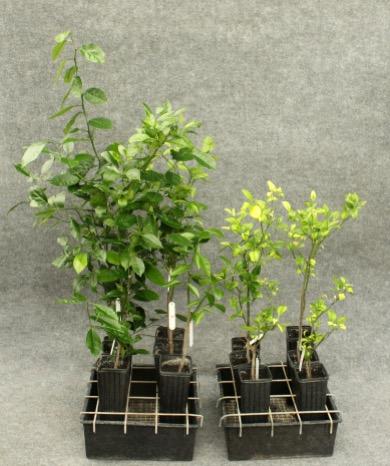
is the technology of choice. However, there is a need to understand why all commercial citrus scions are susceptible, whereas some wild citrus and relatives are resistant/tolerant. For this purpose, we engineered 70 citrus tristeza vectors (CTV) vectors to overexpress or downregulate citrus genes related to plant defense, susceptibility genes, callose deposition, and reactive oxygen species. Among the sweet orange seedlings infected with the different CTV vectors screened, we identified two genes that upon downregulation induce tolerance to HLB. We are continuing to screen all target genes and our collaborators are working on modifying these genes via CRISPR technology.
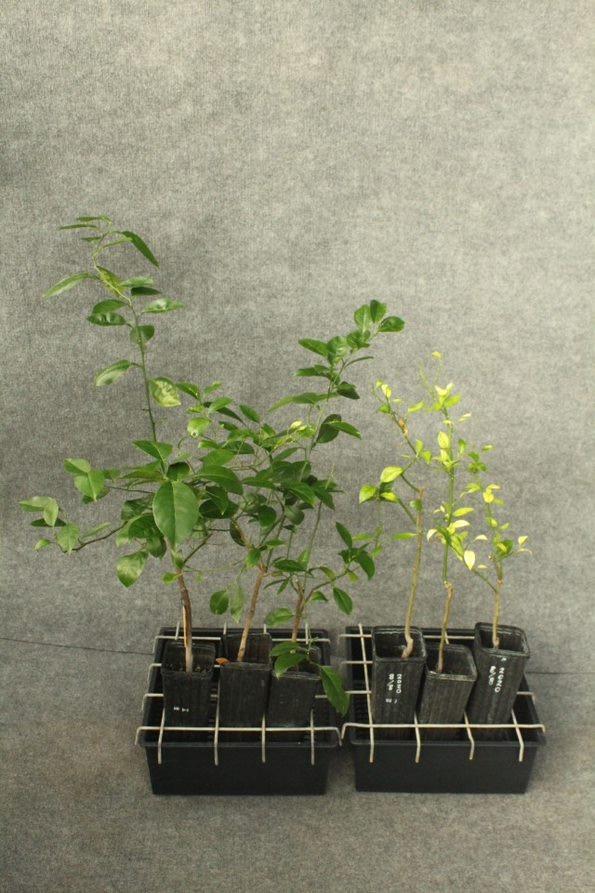
Take Home Message:
• CTV is a faster tool to identify therapeutics against HLB than transgenic or CRISPR strategies.
• Manipulation of a single citrus gene in commercial scions could induce tolerance to HLB.
• The identified target will be used for CRISPR modification to generate tolerant citrus genotypes.
Funding:
Optimal Combination of Bt Toxins and Gene Silencing RNAs for Management of Citrus Root Weevil
Researchers: Bryony C. Bonning, Nabil Killiny, Lukasz Stelinski, Manjul Dutt
Contact: Bryony C. Bonning, UF/IFAS Gainesville bbonning@ufl.edu
Summary:
The citrus root weevil, Diaprepes abbreviatus, also known as the Diaprepes root weevil (DRW), poses a serious threat to the citrus industry. The recent relaxation in chemical insecticide application for management of Asian citrus psyllid, has resulted in a rebound of weevil populations in groves weakened by huanglongbing (HLB), costing Florida citrus growers up to $500/acre for combined DRW and associated Phytophthora control. As current management strategies are proving inadequate, we plan to address the urgent need for new management strategies. Bacillus thuringiensis

(Bt)-derived proteins, along with gene silencing RNAs have been successfully deployed for management of a range of pest insects, most notably against another beetle pest, the corn rootworm. For this project, we aim to screen Bt proteins and gene silencing RNAs for activity against DRW, and to test existing transgenic citrus rootstocks that express Bt proteins for resistance to DRW. Both Bt proteins and gene silencing RNAs have a strong track record as safe and effective insecticides. Elucidation of the best combinations for use against DRW will provide growers with an environmentally friendly option for DRW management.
Take Home Message:
• Diaprepes root weevil larvae are susceptible to the impacts of both Bt proteins and gene silencing RNAs.
• Of 16 Bt proteins and 13 gene silencing RNAs tested, several were toxic to DRW in preliminary bioassays.
• This two-pronged approach will provide for an environmentally benign strategy for DRW management.
Funding:
Edge Effects and Soil Properties Driving the Distribution of Diaprepes abbreviatus
Researchers: Larry
Duncan, Lauren Diepenbrock, Lukasz Stelinski
Contact: Larry Duncan, UF/IFAS CREC
lwduncan@ufl.edu
Summary:
Diaprepes root weevil (DRW, Diaprepes abbreviatus) is a major economic pest of citrus trees in Florida and the Caribbean Basin. To identify potential drivers of local patterns of weevil abundance and tree condition, we measured relationships between DRW and edaphic properties in a Florida grove in which half the trees were initially protected from herbivores by individual protective covers (IPC) of fabric mesh. Weevils were monitored for two years in 94 plots arranged in a grid pattern.
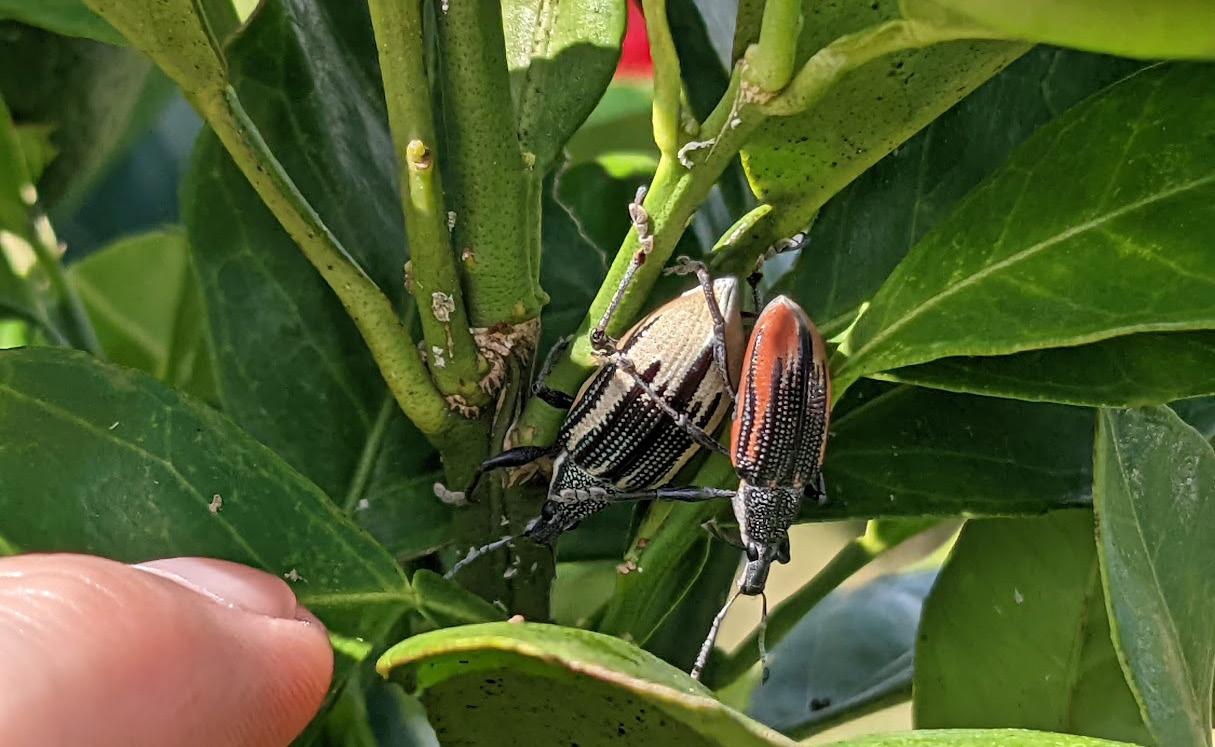
Soil samples were processed for physicochemical properties, and DNA from soil organisms was subjected to metabarcoding for ITS2 rDNA, 16S rDNA, and COI mtDNA. Early season, edge-biased distribution of DRW should be exploited for monitoring and management efficacy. The profound negative association here between IPCinduced, microbiome species deficits and tree mortality supports the need for validation and research to identify mitigating interventions to sustain the benefits of early tree protection afforded by individual protective covers.
Take Home Message:
• Diaprepes weevil populations are first located at field edges.
• Use of IPCs can reduce DRW local infestations.
Funding:
Developing Bulimulus sp. Management in Florida Citrus
Researchers: Lauren Diepenbrock, Nicole Quinn
Contact: Lauren Diepenbrock, UF/IFAS CREC
ldiepenbrock@ufl.edu
Summary:
Bulimulus bonariensis is an invasive land snail species in the Southeastern U.S. that has increasingly infested crops in recent years. In citrus, B. bonariensis has been observed clogging microjets, defoliating trees within individual protective covers, and girdling young trees with preexisting damage. There is very limited information available on population trends and potential chemical control of these snails, which are important to consider when developing management programs. To explore snail population trends, traps were deployed alternately between trees and along grove edges at three sites and were checked for snails biweekly for one year. The count data revealed seasonal trends in snail activity that varied across

sites, highlighting the importance of monitoring. The relative success of flat traps and pyramid traps also varied across sites, suggesting that either could serve as an effective monitoring strategy depending on environmental conditions. Additionally, heat maps indicated a random distribution of snails within fields, implying that whole grove management may be necessary. At present, there are no recommended chemical controls for Bulimulus sp., therefore we screened foliar chemistries and molluscicidal baits registered for use in Florida. Among the treatments, the molluscicidal baits and abamectin topical spray exhibited the highest mortality rates over a two-week period. The results of this study reveal pertinent information that may help growers manage B. bonariensis and mitigate its impact on citrus production.
Take Home Message:
• Bulimulus bonariensis is an invasive land snail that impacts citrus and other crops in Florida.
• Population patterns vary by grove.
• Molluscicidal baits and topical abamectin applications currently produce the highest mortality rates of all materials tested.
Funding:
Tools for Organic Management of Asian Citrus Psyllid
Researchers: Jawwad Qureshi, Lukasz Stelinski, Xavier Martini, Xuedong Chen
Contact: Jawwad Qureshi, UF/IFAS SWFREC
jawwadq@ufl.edu
Summary:
The organic citrus production warrants managing the Asian citrus psyllid (ACP) vector of huanglongbing (HLB) using an integrated approach. Five commercially available predators, including Cryptolaemus montrouzier, Delphastus catalinae, Chrysoperla rufilabris, Orius laevigatus, and Amblyseius swirskii were tested for predatory potential on ACP eggs. Delphastus catalinae was found to be more efficient compared to the other predators. Exochomus childrenii, a lady beetle found in the organic groves, was evaluated for development on immatures of ACP. Its immatures took about four weeks to develop to adulthood at a survival rate of 60%. Females lived for about five weeks and produced a progeny of 45-60 individuals. Similar performance
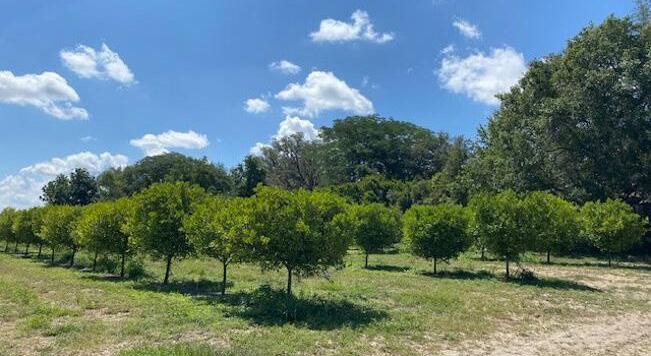
was observed on the diet of black citrus aphid, Toxoptera aurantii, suggesting multiple pest targets. Field research supported the hypothesis that methyl jasmonate is a plant defense phytostimulant which may reduce ACP and HLB. From an early season application of Aza-Direct®, Entrust® , and PyGanic® in an organic citrus block, most suppression was observed from Entrust®, averaging 41-56%. An average reduction of 79%, 63%, and 36% was observed from the treatments of M-pede® (soap), JMS stylet oil®, and Surround® (Kaolin), respectively, one week after application during the growing season. Exclusion experiments revealed 23-75% mortality of ACP immatures. Release of Tamarixia radiata resulted in 14-66% parasitized colonies and parasitism averaging 6483% across three organic programs.
Take Home Message:
• Commercial and naturally occurring predators suppress ACP.
• Release of T. radiata contributes to ACP mortality.
• Biological and chemical tools reduce ACP populations in organic citrus and are useful for other environments area-wide.
Funding:
Influence of Tamarixia radiata on Asian Citrus Psyllid in Brassinosteroids-treated Citrus
Researchers:
Jawwad Qureshi, Fernando Alferez, Xuedong Chen
Contact: Jawwad Qureshi, UF/IFAS SWFREC
jawwadq@ufl.edu
Summary:
Brassinosteroids (Brs) are a natural group of hormones essential for plant growth and development. Spray treatments of Brs are employed to alleviate the negative impact of huaunglongbing (HLB) on citrus trees. The positive effects of their application on HLB-affected citrus trees include a reduction in HLB infection and improved tree performance, as observed in Florida. The Asian citrus psyllid (ACP) vector of HLB is found in all environments, including Brs treated blocks, and warrants management. Natural enemies, including ACP-specific parasitoid Tamarixia radiata, have been shown to contribute to psyllid suppression in the citrus agroecosystems in Florida and elsewhere. Tamarixia radiata is mass-produced and released into the

commercial and urban environments in Florida. We evaluated the performance of this parasitoid in large plots of ‘Early Pride’, ‘Tango’, and Sugar Belle® varieties treated monthly with foliar sprays of Brs and untreated plots. Parasitism rates in the open colonies of nymphs assessed by parasitoid averaged 10-50% in the plots treated with Brs and 13-42% in the untreated plots. Females of T. radiata caged with unparasitized nymphs for one week on trees treated or not with Brs provided, 13-25% and 18-25%, respectively. Tamarixia radiata females caged with ACP nymphs that experienced immediate residual exposure and residual plus contact exposure, provided parasitism of 28-42% and 13-37%, respectively, compared to 32-47% parasitism observed in the untreated control.
Take Home Message:
• Tamarixia radiata, suppressed ACP populations in Brs treated citrus.
• Tamarixia radiata releases are compatible with Brs sprays.
• ACP suppression in Brs treated blocks will reduce spread and severity of HLB and improve tree health.
Funding:
Optimizing dsRNA Concentration for RNA Interference in Asian Citrus Psyllid
Researchers: Jawwad Qureshi, Esmaeil Saberi, Mosharrof Mondal, Jorge R. Paredes-Montero, Kiran Nawaz, Judith K. Brown
Contact: Jawwad Qureshi, UF/IFAS SWFREC jawwadq@ufl.edu
Summary:
The Asian citrus psyllid (ACP) is a citrus pest and insect vector of Candidatus Liberibacter asiaticus, the causal agent of huanglongbing. Double-stranded RNA (dsRNA) biopesticides that trigger RNA interference (RNAi) offer an alternative to traditional insecticides. Standardized laboratory screening of dsRNA requires establishing the minimal effective concentration(s) that result in effective RNAi “penetrance” and trigger RNAi, resulting in one or more measurable phenotypes, herein, significant gene knockdown and the potential for mortality. In this study, knockdown was evaluated for a range of dsRNA concentrations of three ACP candidate genes, clathrin heavy chain (CHC), vacuolar ATPase

subunit A (vATPase-A), and sucrose non-fermenting protein 7 (Snf7). Gene knockdown was quantified for ACP teneral adults and third instar nymphs allowed a 48 h ingestionaccess period (IAP) on 10, 50,100, 200, and 500 ng/µL dsRNA dissolved in 20% sucrose followed by a 5-day post-IAP on orange jasmine shoots. Significant gene knockdown in ACP third instar nymphs and adults ranged from 12–34% and 18–39%, 5 days post-IAP on dsRNA at 10–500 and 100–500 ng/µL, respectively. The threshold concentration beyond which no significant gene knockdown and adult mortality was observed post-48 h IAP and 10-day IAP, respectively, was determined as 200 ng/µL, a concentration indicative of optimal RNAi penetrance.
Take Home Message:
• Use of dsRNA biopesticides offers an alternative to traditional insecticides.
• dsRNA concentration indicative of optimal RNAi penetrance by oral delivery was 200 ng/µL.
• A working threshold can reduce the use of excessive amounts of dsRNA, cost, and potential off-target effects
Funding:
Assessing Entomopathogenic Fungi for Asian Citrus Psyllid Management
Researchers: Jawwad Qureshi, Seth Tsatsu
Contact: Jawwad Qureshi, UF/IFAS SWFREC
jawwadq@ufl.edu
Summary:
The Asian citrus psyllid (ACP) is the primary vector of huanglongbing (HLB) . Multiple tools are needed for developing integrated pest management for ACP. Besides arthropod predators and parasitoids providing biological control, an array of entomopathogenic fungi have been reported to infect ACP including Beauveria bassiana, Cordyceps javanica, and Hirsutella sp. However, little is known about their phenology and impact on the ACP particularly of Hirsutella citriformis which has been observed in citrus groves. Almost two decades ago, a study reported interactions of H. citriformis and ACP resulting in 23% ACP mortality with the maximum of 75%. Our preliminary investigation revealed very low or no
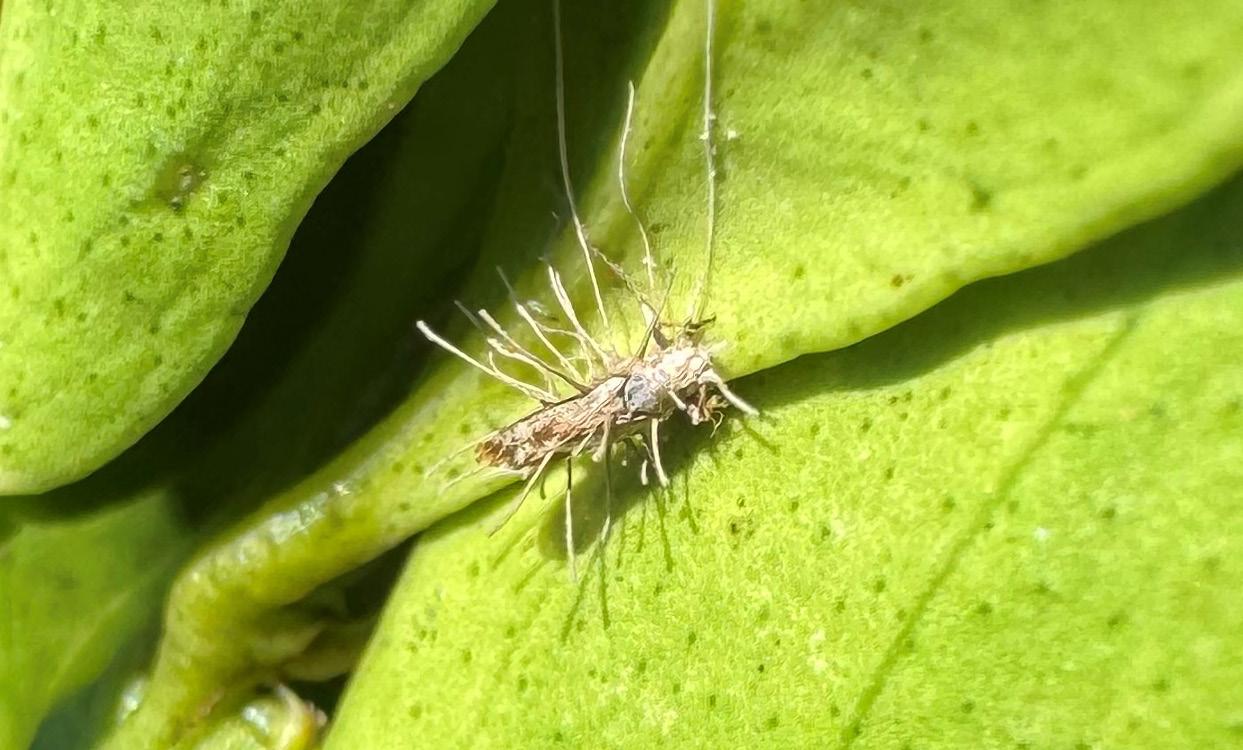
infections in feral ACP in the field. We will be conducting more research this rainy season and following fall and winter as well as evaluating transmission dynamics and impact of H. citriformis and commercially available entomopathogenic fungal products on ACP. Laboratory results in the direct exposure experiments showed 99% ACP mortality within two weeks, highest at 82.4 °F and >90% RH. Field mortality in uninfected ACP adults exposed to infected adults and surfaces averaged 47%, increasing with exposure time. Mycosis occurred in 30% of cadavers from misted cages and 15% from non-misted ones. These findings highlight the potential of H. citriformis in suppressing ACP populations, especially under favorable environmental conditions, supporting its integration into citrus IPM.
Take Home Message:
• Several entomopathogenic fungi have been reported to infect ACP and suppress its populations in the field.
• Commercially available entomopathogenic fungal products have shown impact on ACP.
• Entomopathogenic fungi are an additional important tool for biological control and IPM of ACP.
Funding:
Integrated Huanglongbing Management for Florida Citrus
Researchers:
Ozgur Batuman, Lauren Fessler Mathews, Sanju Kunwar, Ana Redondo, Fernando Alferez, Ute Albrecht, Yannis Ampatzidis
Contact: Ozgur Batuman, UF/IFAS SWFREC
obatuman@ufl.edu
Summary:
No stand-alone strategy has been identified for effective huanglongbing (HLB) management. Our best option to manage HLB in citrus groves relies on using an integrated pest management (IPM) strategy. IPM uses all available disease management tools, including vector management (with insecticide or IPCs), removing unproductive HLBaffected trees to reduce inoculum sources, injecting oxytetracycline (OTC), and using plant growth regulators. Since 2016, our research team has been developing practical solutions against HLB, which Florida citrus growers are increasingly adopting. These include using IPCs during planting to prevent initial infection, trunk injections of OTC to mitigate disease symptoms and improve yield and fruit quality, and applying brassinosteroids (Brs) to shield new
Funding:

growth from reinfection. Additionally, we are assessing new tools such as systemic acquired resistance inducers (SARs), HLB-tolerant interstocks, and an automated trunk injection system. Field studies evaluating these approaches have demonstrated promising results. IPCs effectively block Candidatus Liberibacter asiaticus (C Las) infection, OTC reduces bacterial titers and fruit drop, while Brs and SARs enhance tree productivity and protect new shoots from ACP-mediated reinfections and citrus canker. Collectively, these IPM tools offer a viable strategy for managing HLB in commercial citrus groves, supporting sustainable production despite the disease’s presence. Ongoing field trials aim to refine and integrate these tools into comprehensive IPM programs, with a proposed management plan tailored for Florida groves.
Take Home Message:
• HLB must be managed by using an IPM strategy.
• We identified practical IPM tools for HLB management, including IPCs, OTC-injections, use of SARs, and Brs.
• We propose an IPM strategy that growers can immediately adopt for HLB management.
Endophytes as Sources of Antimicrobials to Control Huanglongbing
Researchers: Kateel Shetty, Megan Dewdney, Amir Rezazadeh, Krish Jayachandran, Diego Salazar Amoretti, Kranthi Mandadi
Contact: Kateel Shetty, Florida International University shett yk@fiu.edu
Summary:
Endophytes are those microorganisms that spend a part of their life cycle within plants without causing disease. These microorganisms are potential sources of antimicrobial compounds that could play a role in sustainable agriculture through direct action on other microorganisms or reducing plant stress or promoting plant growth and yield. These organisms can live in the vascular tissues of plants. The team evaluated the microbiome of survivor (not showing symptoms of huanglongbing (HLB) in an otherwise affected grove) citrus trees and found 4 endophytic bacteria with potential antibacterial properties. The crude
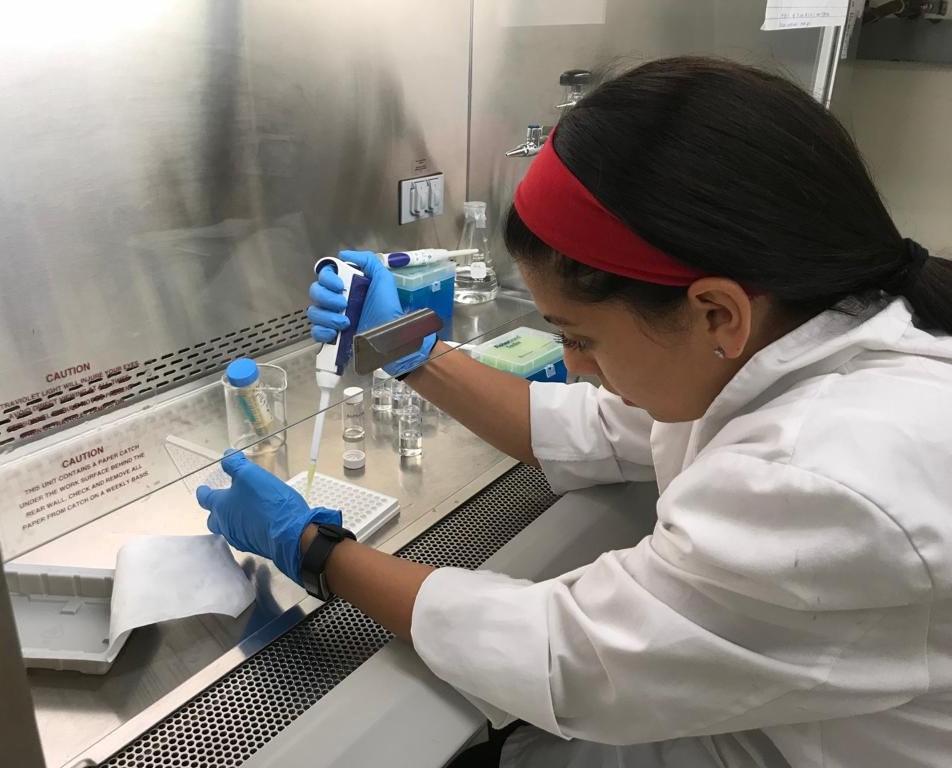
extracts of these bacteria showed antibacterial properties against Liberibacter crescens, the culturable relative of Candidatus Liberibacter asiaticus (C Las) and against C Las cells present in the tissue extract taken from C Las positive psyllids. Work has been done to purify the parts of the original extracts to identify which compounds are the active ones. Fractions of the extracts with activity have been screened with the hairy root assay to see if there is activity against C Las, eliminating some fractions for further testing. Greenhouse trees (‘Valencia’ sweet orange) have been inoculated with C Las and are ready to test the active fractions in whole citrus plants, the next step in the testing process.
Take Home Message:
• Endophytic organisms are a potential source of environmentally safe antimicrobial compounds.
• Endophytic bacteria that have an antiLiberibacter effect were identified from survivor citrus trees.
• The next step is to see if there is activity against C Las in greenhouse trees.
Funding:
What is Causing that Greasy Green Color on my Grapefruit?
Researchers: Megan Dewdney, Mark Ritenour, Liliana Cano
Contact: Megan Dewdney, UF/IFAS CREC
mmdewdney@ufl.edu
Summary:
In the last five years, 89% of grapefruit growers have struggled with a disorder that they refer to as greasy-green, leading to losses between $20,000 to $1.7 million per year. The disorder causes the fruit to have large, diffuse green patches on the rind after degreening, making it no longer suitable for the fresh market. The disorder visually resembles rind blotch, caused by the fungus Zasmidium citri-griseum (formerly known as Mycosphaerella citri ), but there are nearly no symptoms on leaves. The cause of greasy-green remains unclear, but in Spring 2022, UF/IFAS started a project to determine if the epiphytic growth of Z. citrigriseum was different, possibly in response to changes in the host caused
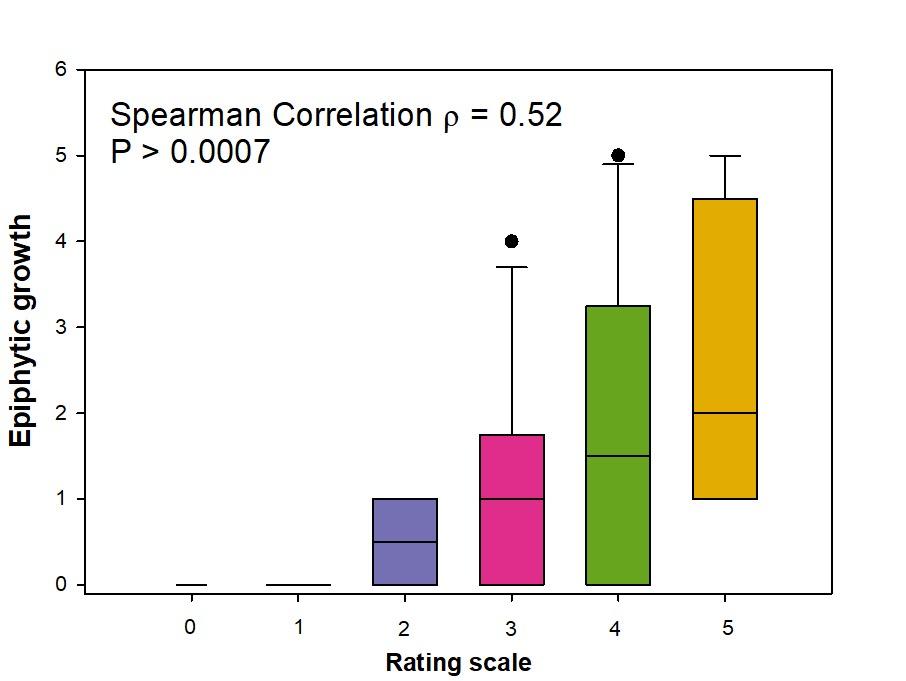
When there is an increase in the measured amount of fungal growth on fruit surface (epiphytic growth), there is an increase in the amount of observed greasy green (rating scale) after a degreening treatment.
by huanglongbing (HLB), a warmer environment, or cultural practices. From leaf samples, despite there being no disease symptoms on the leaves in the grove, epiphytic (plant surface) growth started in May and June. There were symptoms on the fruit. Post-harvest degreening trials were conducted. While degreening, with or without 24 hours at 38 °F, significantly improved peel color compared to just 38 °F or no treatment, a green color remained. In addition, when samples were taken from fruit, there was more epiphytic growth on fruit with symptoms than asymptomatic fruit and the increased intensity of the symptoms corresponded with greater epiphytic growth. Confirmation studies are on-going to ensure our conclusions are correct.
Take Home Message:
• Despite leaf symptoms of greasy spot not being visible, we can detect Z. citri-griseum growth on the leaf surfaces.
• On fruit with severe greasy green, we observe more Z. citri-griseum spores and surface growth.
• Post-harvest degreening has not reduced the greasy green symptoms on affected fruit.
Funding:
How Far can the Inoculum for Citrus Black Spot Travel Up?
Researchers: Megan Dewdney
Contact: Megan Dewdney, UF/IFAS CREC
mmdewdney@ufl.edu
Summary:
Citrus black spot is a quarantine disease that causes fruit symptoms that can lead to significant yield loss in bad years. To date, it is primarily in the southwest Florida citrus production region, although it has been found further north more recently. In Florida, only one type of spore is present to cause disease rather than the two found in most other places. The spores present in Florida are moved by splash short distances (less than 32 inches), mostly downwards from their source. They are recorded to only travel 3 inches upwards. However, when looking for the major source of spores, we discovered that they were primarily in the leaf litter throughout the year. The question that needs to be
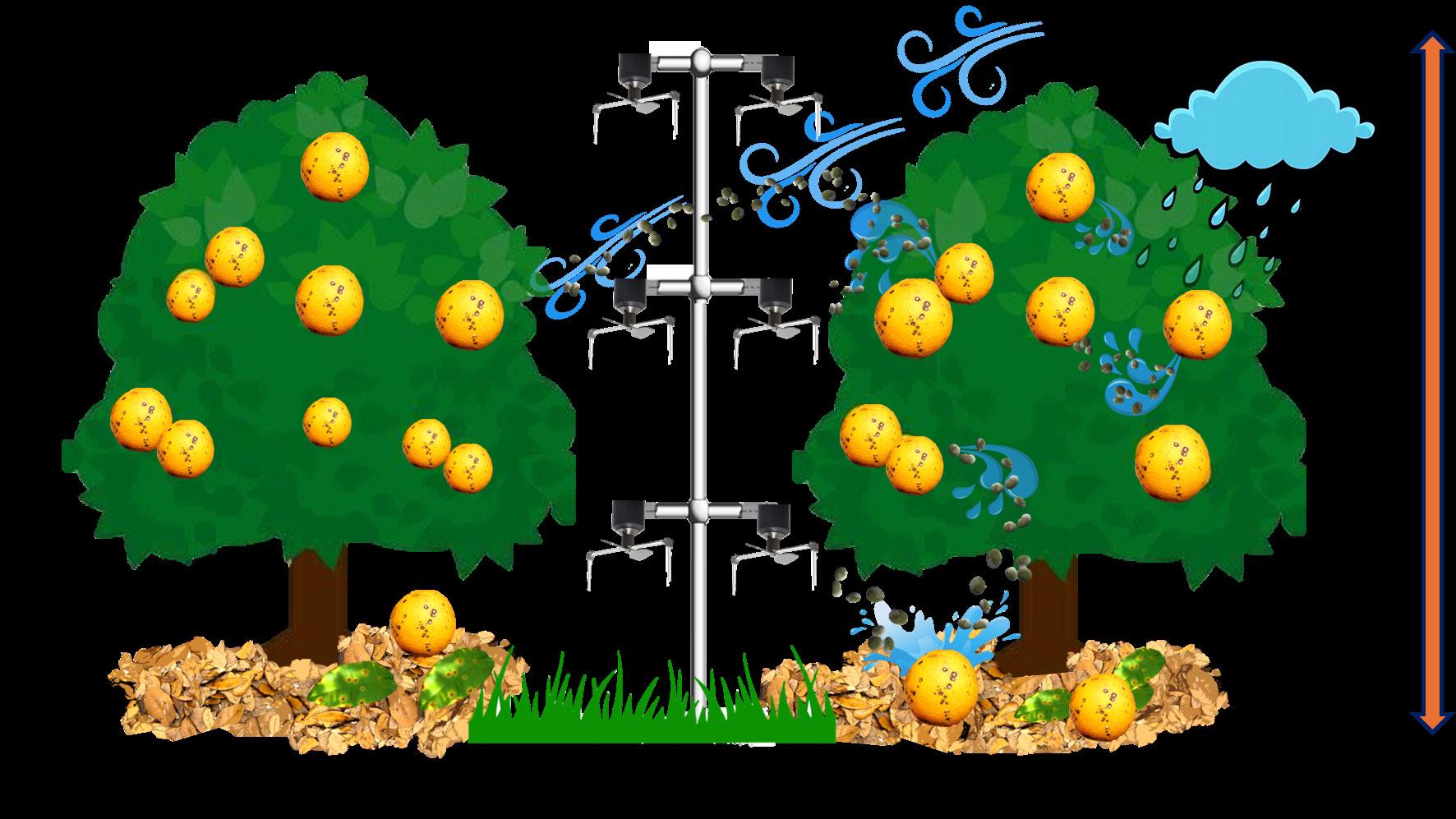
answered is are those spores in the leaf litter traveling up into the canopy and if so, how. We are developing a spore trapping system to collect spores in an array from the grove floor to the top of the canopy to see how many spores are collected and what the weather conditions were like at the time they were captured. This will help establish how far these spores can travel under the wind-blown rain conditions found in Florida. The information will help us understand how this disease, which is not supposed to spread quickly or far is being moved long distances and help us understand the role of extreme weather events like tropical storms. Currently, the spore trap towers are under construction and should be deployed soon.
Take Home Message:
• It is unusual to have only the splash dispersed form of spores for citrus black spot.
• It is not understood how the spores move from the high inoculum leaf litter to the top of the tree canopy.
• The data from this study will help us understand how the spores move within a grove and spread the disease.
Funding:
Illustration of spores produced in infected plant parts being dispersed by the wind or water-splashed and captured by a rotating arm spore trap placed at different heights. Image credit: Pamela Dutra, 2025.
Use of Systemic Acquired Resistance Inducers to Protect New Flushes from Huanglongbing and Citrus Canker

Researchers: Ozgur Batuman, Bayer Crop Science: Denise Manker, Jeremy Dufour, Thomas Knobloch, Stephane Brunet
Contact: Ozgur Batuman, UF/IFAS SWFREC
obatuman@ufl.edu
Summary:
A therapeutic screening pipeline for huanglongbing (HLB) management was established, where we identified compounds of interest that include a class of synthetic systemic acquired resistance (SAR) inducers in citrus trees. These SARs have been tested for their efficacy in preventing HLB infection of young shoots (in the greenhouse) and slowing HLB infection of new trees (in the field). By spraying SAR treatments on young flushes before Asian citrus psyllid (ACP) colonization to activate plant defense (priming) and prevent bacterial infection, we observed that young flushes could
be protected from reinfections of the HLB-causing bacterium due to ACP feeding. Some preliminary field experimental results were encouraging, providing a substantial delay in HLB infection (~3-7 months) after 2-3 applications. Moreover, some SARs were also significantly effective in citrus canker control. We are currently testing some of these compounds on newly established citrus trees across 4 grove sites in Florida. We propose that emerging young flushes, particularly after OTC injection or IPC removal from young trees, could be sprayed with SARs to protect them from HLB in the grove.
Take Home Message:
• New flushes must be protected from ACP feeding and HLB reinfections.
• Spray of plant defense inducers can protect young flushes from HLB, citrus canker, and ACP feeding.
• SARs can be used after OTC efficacy starts declining and after IPC removal to protect young flushes.
Funding:
Oxytetracycline Trunk Injection Tips
Researchers: Ute Albrecht, Larissa Nunes, Gabriel Pugina, Caroline Tardivo, Jasmine Freitas, Gerardo Moreno, Igor Rodrigues, Deived Carvalho
Contact: Ute Albrecht, UF/IFAS SWFREC
ualbrecht@ufl.edu
Summary:
Injection Timing
• Inject at least 180 days before harvest.
• Injections are best performed during spring and early summer.
• Injections performed later in the year result in a higher Brix, but…
• … injections performed later than July result in high fruit residues.
• Inject when leaves are fully expanded and during the morning.
• Trees should be well-hydrated at the time of injection.
Performing the Injections
• Follow label instructions to determine the correct oxytetracycline (OTC) dose.
• Ensure the OTC solution is acidified correctly.
• Use only freshly prepared OTC solution. The solution should be yellow and clear.
Funding:

• Use a smaller drill bit and applicator tip for smaller trees to reduce trunk injury.
• Both rootstock and scion injection are effective, but young trees and trees with a short trunk are better injected into the rootstock.
• Subsequent injections should be performed opposite to the previous injection or spaced apart by several inches.
• Do not inject right next to, or into a previous injection site.
Phytotoxicity and Sectoring
• Moderate phytotoxicity (leaf yellowing, bronzing) to severe phytotoxicity (leaf drop, twig dieback, fruit drop) may occur after injection.
• To reduce phytotoxicity and sectoring, try injecting half of the desired OTC dose each on two different sides of the trunk.
• Consider using a smaller applicator tip when performing two-sided injections.
• Do not inject directly underneath a main scaffold branch when performing one-sided injections. Aftercare
• Good tree care is important for tree recovery.
• Continue to manage psyllids. OTC injections are no replacement for psyllid control.
Take Home Message:
• OTC injections are effective.
• Injections must be performed properly to maximize the beneficial effects.
• OTC injections are no replacement for psyllid control and other good tree care practices.
The Month of Injection Affects Fruit Size, Juice Quality, and Oxytetracycline Residues
Researchers: Ute Albrecht
Contact: Ute Albrecht, UF/IFAS SWFREC
ualbrecht@ufl.edu
Summary:
Citrus fruit development can be divided into three somewhat overlapping phases or stages: stage I (cell division), from anthesis to the end of physiological fruitlet abscission (June drop), during which cell division predominates and growth is moderate; stage II (cell enlargement), from the end of June drop to shortly before fruit color change, during which cells enlarge rapidly and fruits reach their final size; and stage III (maturation), during which no more growth occurs and fruits begin a non-climacteric ripening process. The month of injection can have a major influence on fruit size, fruit color, and juice quality. Injections during stage I promote cell division, ultimately resulting in larger fruits. The earlier the
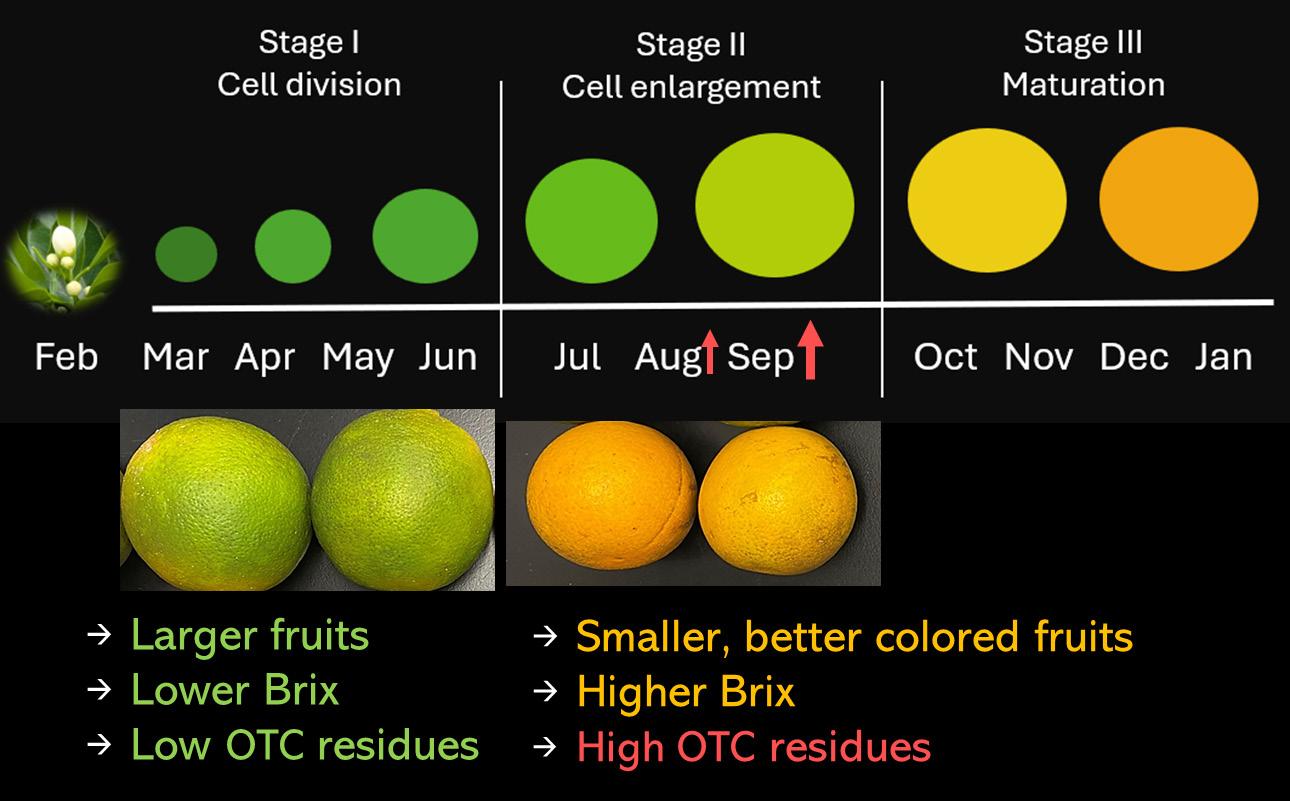
injection occurs the larger the fruits will be. These larger fruits are likely to need a longer maturation time and, if picked early, will usually be greener and contain fewer soluble solids, i.e., have a lower °Brix. OTC fruit residues will be low as any OTC that has accumulated in the fruitlets will be diluted during cell growth and expansion. In contrast, injections during the cell enlargement stage (stage II) will have a lesser impact on fruit size but will promote soluble solids accumulation, resulting in a higher °Brix. These fruits usually also have a better peel color. The later the injection, the more pronounced this effect will be. However, injections at the end of stage II (e.g., in September) will result in high OTC residues as no more growth occurs, preventing its dilution.
Take Home Message:
• The month of injection determines fruit and juice quality.
• Injections early in the year promote fruit size.
• Injections late in the year promote juice quality but increase OTC residues.
Funding:
Oxytetracycline Injections - Sectoring and Phytotoxicity
Researchers: Ute Albrecht, Larissa Nunes, Gabriel Pugina, Igor Rodrigues
Contact: Ute Albrecht, UF/IFAS SWFREC
ualbrecht@ufl.edu
Summary:
Trunk injections are mostly performed on one side of the tree. In the following year, the injected side generally looks considerably better than the noninjected side. This is also reflected in the better quality of the fruits in terms of size, peel color, and °Brix. To reduce sectoring, injections may be performed two-sided, that is injecting half the dose of oxytetracycline (OTC) on two (opposite) sides of the trunk. However, even with two-sided injections, some sectoring may still occur. Dye injections can visualize this phenomenon. The photo shows that despite the twosided injection, most of the dye moved into one branch of the tree, likely the one originating closest to the injection side and most metabolically active at the time of injection. Such dye studies also demonstrate why phytotoxic
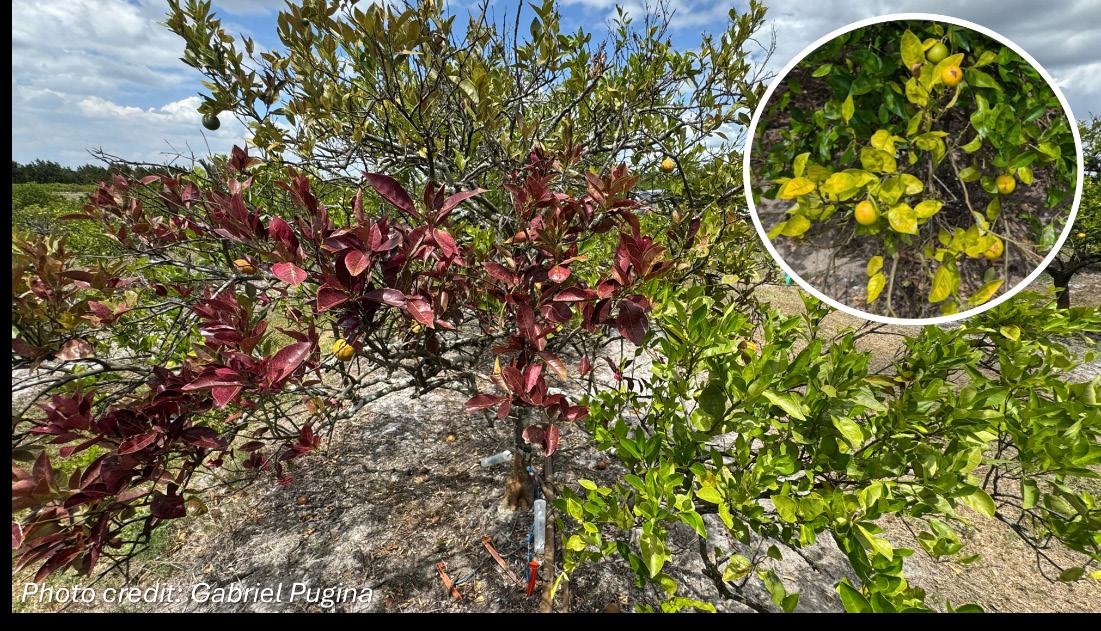
effects can occur in response to OTC injections. Those sections in the canopy receiving most of the chemical are likely to express the most phytotoxicity. Moderate phytotoxicity manifests as yellowing of the leaves, which usually disappears during the growing season. These sections of the canopy will ultimately be the healthiest. Severe phytotoxicity includes twig die-back and fruit drop but is usually limited to small sectors in the canopy. Phytotoxic effects do not seem to be related to the month of injection but rather to local growing conditions. Apart from performing two-sided injections, reducing tree stress prior to the injections may help reduce the risk of phytotoxicity. Some sectoring will always occur but will likely be less evident after consecutive years of injection.
Take Home Message:
• Uneven OTC distribution may lead to phytotoxicity and sectoring.
• Both phytotoxicity and sectoring may be reduced by two-sided injection.
• Dye injections visualize the uneven distribution in the canopy.
Funding:
Oxytetracycline Fruit Residues
Researchers: Ute Albrecht, Gabriel Pugina
Contact: Ute Albrecht, UF/IFAS SWFREC ualbrecht@ufl.edu
Summary:
The currently allowed maximum residue level (MRL) of oxytetracycline (OTC) in the fruits is 10 parts per billion (ppb) or 0.01 parts per million (ppm). A study was conducted to determine whole fruit (peel and juice) residues in response to different doses of OTC and different months of injection. The trees in this study were 18-year-old ‘Valencia’ on Swingle rootstock. Trees were injected with OTC in 2023 and 2024 using 100 ml of a 5,500 ppm, 8,250 ppm, or 11,000 ppm solution (0.55 g, 0.825 g, or 1.1 g OTC per tree). Injections were performed on one side of the tree using FLexInject™ injectors. In year 1, injections were performed either in June or September. In year 2, injections were performed either in
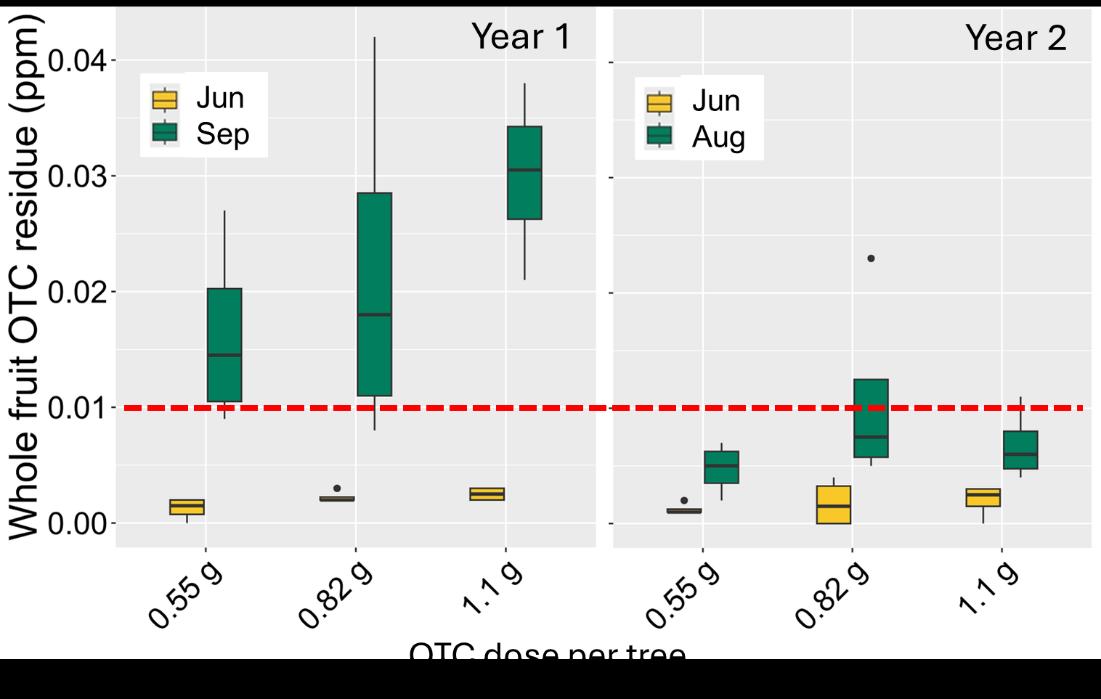
June or August. Fruits were harvested in March 2024 and 2025. A random subset of fruits was collected from each treatment and homogenized in a blender. The homogenate was analyzed for OTC by an ISO/IEC 17025 accredited laboratory using LC-MS/ MS. In both years, OTC fruit residues were below the MRL when injections were performed in June, regardless of the OTC dose. When injections were performed in September (year 1), residues were considerably higher than the allowed MRL, and a higher OTC dose resulted in higher residues. When injections were performed in August (year 2), average OTC residues were below the MRL, but individual samples exceeded the allowed level of 0.01 ppm. It is therefore recommended to complete all injections before August.
Take Home Message:
• The maximum allowed residue level of OTC in the fruits is 0.01 parts per million (10 parts per billion).
• Fruit OTC residues depend on the month in which injections are performed.
• Injections performed in late summer/ fall generate high OTC residues.
Funding:
Potential Rotational or Alternative Partners of Oxytetracycline for Huanglongbing Management

Contact: Ozgur Batuman, UF/IFAS SWFREC obatuman@ufl.edu
Summary:
The antibiotic oxytetracycline (OTC) can suppress the population buildup of Candidatus Liberibacter asiaticus (C Las) in huanglongbing (HLB)-affected trees through trunk injection. Florida citrus growers have been utilizing this technique since 2022; however, scientists anticipate OTC resistance development in C Las populations. Such resistance development may be slowed by rotating OTC with a different antibiotic, ideally with different modes of action. Instead of injecting citrus trees with only OTC each year, we are investigating trunk injections with OTC in the spring, after the spring flush is fully expanded (April-May 2024), and then subsequently in the fall (September-October 2024) in the same trees with a different antibiotic. This antibiotic rotation method would help to control C Las in HLB-
Funding:
Proposed oxytetracycline (OTC) rotational antimicrobials, and their effect on bacterial (CLas) titers in Valencia trees at 4 months after spring injections (i.e., 1 month after fall injection) that were determined by qPCR (Ct values). Arrows indicate equally or better treatments for CLas control than OTC when rotated. Abbreviations are as follows: OTC = oxytetracycline, KA = kasugamycin, OA = oxolinic acid, STR = streptomycin, VAL = validamycin A, NA = nalidixic acid, GENT = gentamicin, IC = imidacloprid, ASM = Actigard, PDI = Plant Defense Inducer.
affected trees, extend the efficacy of OTC for citrus growers as long as financially possible, and slow down OTC resistance development in C Las bacteria. The overall goal of this project is to determine whether or not OTC, rotated with another antimicrobial, has an equal or better effect on C Las titers than injecting OTC alone in HLBaffected citrus trees without causing phytotoxicity. Therefore, we will utilize sequential trunk injections of 5 different antibiotics. We also want to monitor the phytotoxicity for each antibiotic rotation regimen to ensure growers will use the safest products/concentrations for their trees. By finding antibiotics that can serve as rotational partners to OTC, we can help slow down OTC resistance development in C Las bacteria and extend the financial benefits of OTCtrunk injections until a more long-term HLB solution is developed.
Take Home Message:
• OTC injections currently suppress C Las, but resistance may occur within a few years.
• Trunk injections of different antibiotics have the potential to control C Las but need to be assessed for phytotoxicity.
• OTC resistance development could be slowed by rotating trunk injections with different antibiotics.
Oxytetracycline Efficacy is Impacted by Exposure to Field Conditions
Researchers: Ozgur Batuman, Lauren Fessler Mathews, Sanju Kunwar, Ana Redondo
Contact: Ozgur Batuman, UF/IFAS SWFREC
obatuman@ufl.edu
Summary:
Research conducted by scientists at the UF/IFAS has demonstrated that injections of oxytetracycline (OTC) can help to alleviate symptoms caused by huanglongbing (HLB) disease. OTC is a bacteriostatic compound that inhibits bacterial growth and replication. Like many antibiotics, OTC is sensitive to degradation under certain conditions, including high temperatures and intense UV radiation, which are inherent to Florida citrus groves. This degradation can be observed in the color change of the solution from bright yellow to dark brown. In July 2023, trees were injected with water, fresh OTC, and OTC that had been exposed to environmental conditions in the grove for 6, 24, or 48 hours. HLB management

Funding: Note:
was evaluated monthly based on Candidatus Liberibacter asiaticus (C Las) titer quantification (i.e., qPCR) and visual disease ratings. Four months post-injection, only the freshly prepared OTC significantly reduced C Las titer compared to the water-injected control, indicating even 6 hours of exposure did not provide sufficient HLB control in this grove. This experiment was repeated in 2024 with the same treatments used in 2023, plus treatments with OTC that had been exposed for shorter intervals, including 1.5 and 3 hours. Data from 2024 is currently being analyzed. This study aims to establish a definitive threshold for the duration that filled injectors can be exposed to field conditions before losing efficacy in managing HLB.
Take Home Message:
• Field conditions, including high temperatures and intense UV radiation, degrade OTC.
• Always prepare fresh OTC and inject it into trees immediately; OTC degrades quickly.
• Well-irrigated trees can uptake the OTC faster, and may reduce the duration of OTC heat and UV exposure in the grove.
Oxytetracyclline Adoption and Outcomes Survey - Growers’ Costs and Yields
Yield Increases Since OTC Use
Researchers: Tara Wade, Kelvin Amon, Ozgur Batuman, Yiannis Ampatzidis, Ute Albrecht, Fernando Alferez, Nabil Killiny, Amit Levy, Veronica Ancona
Contact: Tara Wade, UF/IFAS SWFREC tara.wade@ufl.edu
Summary:
Trunk injection is an alternative method for systemically delivering pesticides in woody crops. Compared to foliar sprays, it offers greater precision, improved safety, and reduced environmental impact. In Florida, trunk injection of oxytetracycline (OTC) is believed to be widely adopted by citrus growers as a strategy to manage huanglongbing (HLB). In 2024, 2 years after EPA approval of OTC for trunk injection, we conducted a statewide online survey to assess adoption, grower experiences, and perceived outcomes of this practice. The survey collected data on application costs, yield impacts, tree health, cultural practices, and farm demographics. We obtained usable responses from 80 citrus growers representing over 27,800 acres across
Percent of growers who reported yield increases due to OTC use. *IDK denotes “I don’t know”
21 counties. Among these, 78.8% reported using OTC on 94.3% of their citrus acreage, while another 13.8% planned to use it on an additional 1.3% of acreage. Usage varied from 20% to 100% of planted acres, with 82.5% of respondents applying OTC to more than half their acreage, including 28.6% who applied it to all planted acres. Excluding outliers, growers reported an average OTC application cost of $1.32 per tree, with 76% citing costs between $1.00 and $1.50 per tree. Most respondents (84.5%) reported increased yield (boxes per acre), with 48% noting gains of 10% to 20%. In addition, 55% reported a 15% to 25% increase in pounds solids, and 50% reported a 5% to 15% increase in °Brix ratio. Fruit drop reductions were observed by 87.5% of growers, with 60.7% reporting decreases of 20% to 30%.
Take Home Message:
• On average, OTC costs $1.32/tree.
• Most growers reported increased yields, increased °Brix ratio, and increased pounds solids due to OTC use.
• Most growers reduced fruit drop due to OTC use.
Funding:
Evaluation of Trunk-injected Antibiotics for Huanglongbing Management in Citrus
Researchers: Lukasz Stelinski, Izabella Martinez, Erik Roldan, Kirsten PelzStelinski, Lauren Diepenbrock
Contact: Lukasz Stelinski, UF/IFAS CREC
stelinski@ufl.edu
Summary:
Recent studies have demonstrated that trunk-injected oxytetracycline (OTC) can effectively reduce Candidatus Liberibacter asiaticus (C Las) levels in mature citrus trees, leading to improved yield. Furthermore, OTC treatments have been shown to decrease C Las acquisition by both adult and nymph ACP, thereby disrupting pathogen transmission. However, the development of resistance to OTC necessitates exploration of alternative antimicrobial treatments to rotate with OTC. In this context, streptomycin has emerged as a potential rotational

candidate for trunk injection. The objective of this investigation was to evaluate the efficacy of streptomycin with and without co-injected OTC, as an alternative treatment for remediation of HLB symptoms in commercial citrus. We monitored C Las infection in treated trees up to 300 days post-injection and quantified the effects of the treatments on pathogen acquisition, tree growth, and yield. Our results indicate that both streptomycin and OTC similarly reduce C Las abundance in trees, disrupt pathogen acquisition by ACP, and increase yield as compared with noninjected controls.
Take Home Message:
• Trunk-injected antibiotics reduce pathogen in tree phloem.
• Trunk-injected antibiotics reduce pathogen transmission by psyllids.
• Trunk-injected antibiotics increase yield.
Funding:
Improving the Systemic Uptake of Therapeutic Compounds by Trunk Injections
Researchers: Amit Levy, Christopher Vincent, Nabil Killiny
Contact: Amit Levy, UF/IFAS CREC
amitlevy@ufl.edu
Summary:
Trunk injection is playing a major role in the survival of Florida’s citrus industry until more long-term solutions are developed. However, injection also causes injury to the trunk around the injection sites, which plugs the xylem and the phloem in the area. This injury will not only reduce the efficiency of the substance uptake and systemic movement, but also force to apply another drilling at a different location for subsequent injections. This wound response involves, in part, the plugging of the phloem by callose, which blocks the phloem. Therefore, there is a need
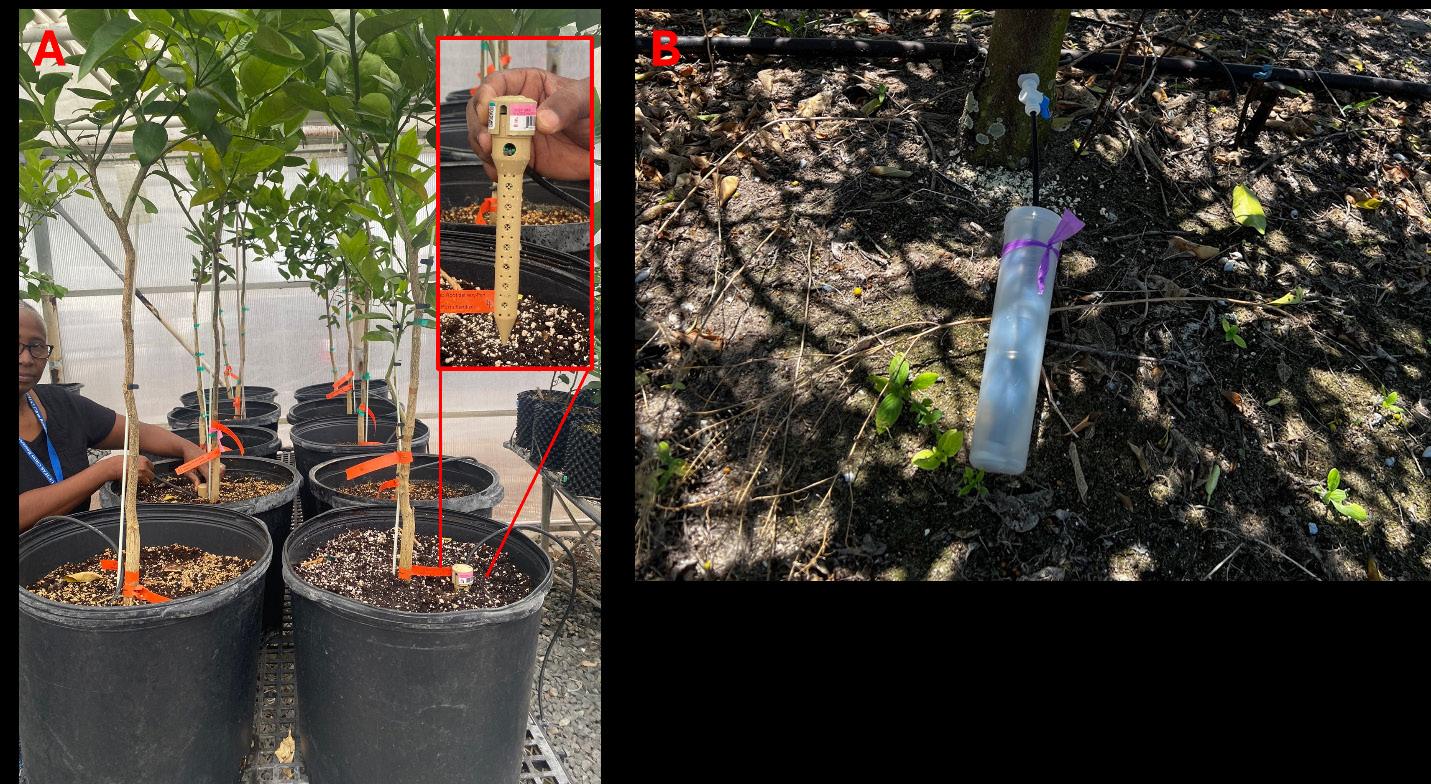
to improve the injection process so that the xylem and phloem don’t get plugged and can support a continuous flow of the antimicrobials in addition to water, sugars, and nutrients. We are working on improving the trunk injection process such that it will not lead to a determinantal plugging of the xylem and phloem. We will do this with these objectives by either using callose inhibitors to improve systemic uptake and reduce huanglongbing symptoms or by targeted root delivery using root aeration and watering tubes to encourage root growth and root tip proliferation around the tubes.
Take Home Message:
• Trunk injection of a callose inhibitor reduced phloem plugging by callose.
• Callose inhibitor increased sugar transport.
• Watering tubes increased the development of roots tips near the port, and the overall development of the root system.
Funding:
Enhancing the Delivery of Therapeutics into Citrus Phloem by Linking Sugar Molecules
Researchers: Amit Levy, Tripti Vashisth, Christopher Vincent, Zhongwu Guo, Kranthi Mandadi, Sandipa Gautam
Contact: Amit Levy, UF/IFAS CREC amitlevy@ufl.edu
Summary:
Huanglongbing (HLB) is associated with defense responses in the phloem, where the bacterium resides, that inhibits of sugar and nutrient transport. Reducing Candidatus Liberibacter asiaticus (C Las) by trunk injection of antimicrobials, such as oxytetracycline, increased yields, canopy density and fruit health, and reduced fruit drop. However, we are currently unable to target antimicrobials and other therapies specifically to the phloem. The phloem is a narrow and selective tissue buried inside the stem, resulting in a very small percentage of the active ingredient entering the phloem, while most of the material injected reaches the xylem, where no C Las is present. To address this challenge, we propose to take advantage of recent findings,
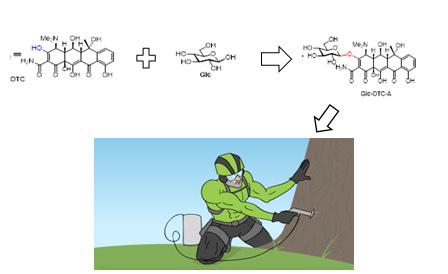
that adding a glucose molecule to different compounds promotes loading into the phloem and increases their phloem mobility. These discoveries showed that the glucose molecule could be recognized by certain phloem transporters and deliver the glucoselinked fluorescent molecules into the phloem. Building on this finding, we will add a glucose molecule to various antimicrobials. We expect this innovation to dramatically improve the efficacy against C Las and reduce the effective dose needed for efficient HLB control by increasing loading into the phloem and reducing environmental risk and the costs of treatment. The glucose-linked therapies that show promising improvements in citrus health can be further commercialized to make them available as products.
Take Home Message:
• Antimicrobials loading into the phloem is the major barrier to efficient C Las targeting.
• Adding a glucose molecule to nonphloem-mobile molecules resulted in active loading into the phloem.
• We are testing whether adding glucose to antimicrobials increases their phloem uploading and efficiency in citrus.
Funding:
ATIS: Automated Trunk Injection System to Treat Huanglongbing-affected Citrus Trees


Researchers: Ozgur Batuman, Yiannis Ampatzidis, Ute Albrecht, Fernando Alferez, Tara Wade
Contact: Ozgur Batuman, UF/IFAS SWFREC obatuman@ufl.edu
Summary:
Current devices for introducing liquid materials such as oxytetracycline (OTC) into citrus trunks are drill-based, relatively large-sized, single injectors, and laborious, which sometimes cause phytotoxicity. We developed an automated trunk injection system (ATIS) consisting of needle-based multiple injectors to reduce injury and effectively deliver therapeutics to citrus vascular tissues through the trunk to improve plant health and performance. The prototype of ATIS developed at UF/IFAS Southwest Florida Research and Education Center in Immokalee effectively grips and penetrates the trunk of mature citrus trees from both sides and injects label-recommended 100 ml of OTC in 30 seconds and up to 250 ml in a minute. The current ATIS does not cause noticeable damage, but longer-term effects must
Funding:

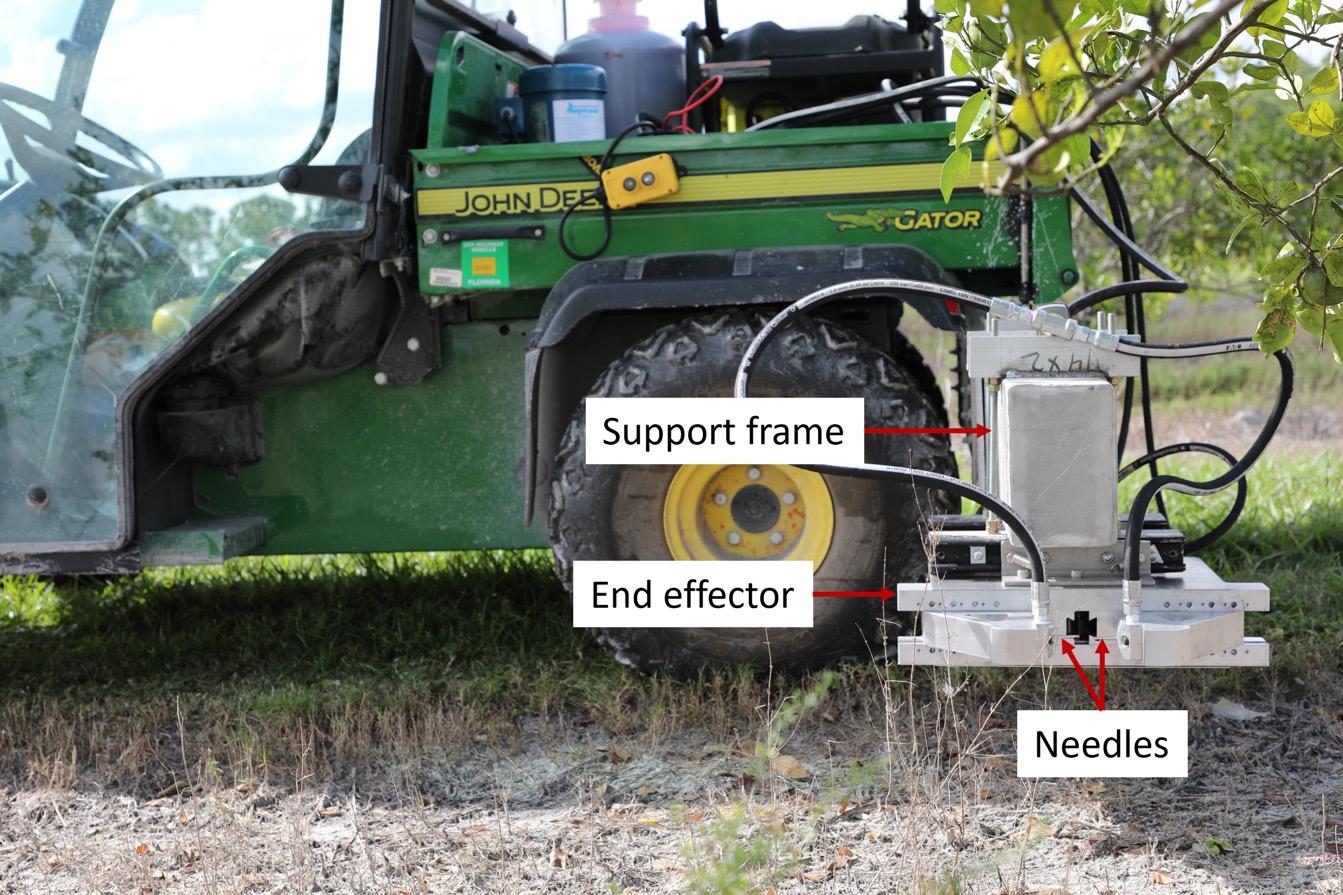



be determined. We are now injecting OTC with ATIS and manual injection devices (grower standards) in a commercial citrus grove to document its effectiveness in faster and better distribution of OTC throughout the canopy and economic feasibility for large-scale production. ATIS with two-sided injections into the trunk is expected to reduce OTC’s heat- and UVassociated field degradation, increasing its effectiveness with faster and better distribution in the tree. ATIS could be further modified and improved with AI-enhanced technologies to make it autonomous and reduce or eliminate extensive shear and tear due to its repetitive use on mature trunks to treat hundreds of trees much faster. Later, we will showcase the ATIS in several growers’ groves who are interested in trying it throughout Florida’s main citrus production regions.
Take Home Message:
• ATIS can inject OTC rapidly and effectively from both sides of the tree trunk for better OTC distribution.
• ATIS may help overcome OTCinjection challenges, including poor uptake and distribution, degradation, and labor costs.
• ATIS’s long-term tree injury, economic feasibility, and scalability are yet to be determined.
Learning about Greasy Spot within the Citrus Under Protective Screen Production System
Researchers: Megan Dewdney, Lauren Diepenbrock
Contact: Megan Dewdney, UF/IFAS CREC
mmdewdney@ufl.edu
Summary:
The citrus under protective screen (CUPS) system has allowed for the ability to produce high-quality fresh fruit in areas that are afflicted by huanglongbing (HLB). The most common type of citrus currently being produced in CUPS is grapefruit. Grapefruit is notorious for being highly susceptible to many foliar diseases and being within the CUPS environment has not changed this. Greasy spot is the most troublesome of the foliar diseases within the CUPS system so far. It can cause damage to the fruit rind, lowering packout, but most importantly leaf symptoms can cause premature leaf drop and yield reduction. To understand where spores are coming from and when, we have been spore trapping within CUPS structures. To date, we have found that more spores


are found near the walls of CUPS compared to the middle, although there are enough spores to cause disease in either location, implying many spores are passing through the screen into the structures. We have observed that the majority spores eject from 4 am to 12 pm. This is likely because of the morning irrigation cycle and wetting from dew leaving a film of water on the leaf litter where the spores are formed. This may mean that inoculum reduction strategies like accelerated leaf litter decomposition may be minimally effective if there are nearby groves that can be inoculum sources. However, leaf litter management still needs to be tested to show whether there would be a sufficient disease reduction for it to be an economically viable management practice.
Take Home Message:
• Greasy spot can reduce yields even in a CUPS environment.
• The fungal spores can easily enter a CUPS structure, leading to infection regardless of practices with an operation.
• Greasy spot management programs in CUPS may need to consider the management occurring in surrounding groves.
Funding:
UF/IFAS Citrus Initiative
Developing Management for Chilli Thrips in Citrus Under Protected Screen Production Systems
Researchers: Lauren Diepenbrock, Megan Dewdney
Contact: Lauren Diepenbrock, UF/IFAS CREC
ldiepenbrock@ufl.edu
Summary:
The citrus under protected screen (CUPS) production environment has provided growers the ability to produce high-quality citrus fruits in regions impacted by huanglongbing (HLB). Over time, however, pest management needs have become apparent within this system, including the need for information regarding chilli thrips seasonality and available management options. Chilli thrips are small, migratory, invasive insects that will feed on young foliage and developing fruit. The damage to fruit leaves silver scarring similar to that seen by broad mites and renders the fruit unmarketable. Over 2 years, we have documented the influx and establishment of chilli thrips into and throughout commercial CUPS structures. Our data suggest that
Funding:

most of the chilli thrips population is comprised of not year-round residents of CUPS, but rather largely comprised of a spring migration into CUPS concurrent with spring exterior weed development. Chilli thrips then drift through the CUPS screen and establish on available weeds, moving into citrus to feed, but not likely using citrus as a reproductive host. Once chilli thrips have established on the edges of CUPS, they migrate throughout the structure, damaging fruit and young leaves well into the interior of the structure. To date, growers who have adopted regular weed management both inside of their CUPS and in the adjacent fields have noted a significant reduction of damage from chilli thrips to their crop. In addition to this work, we are in the process of screening available insecticides that can be incorporated into a broader management plan.
UF/IFAS Citrus Initiative
Take Home Message:
• Chilli thrips are pests in CUPS and require management to protect fruit aesthetic.
Establishing Biological Control in Citrus Under Protective Screen Production Systems: Florida Red Scale and Aphytis melinus
Interaction
Researchers: Jawwad Qureshi, Salman Al-Shami, Mark A. Ritenour, Arnold Schumann
Contact: Jawwad Qureshi, UF/IFAS SWFREC
jawwadq@ufl.edu
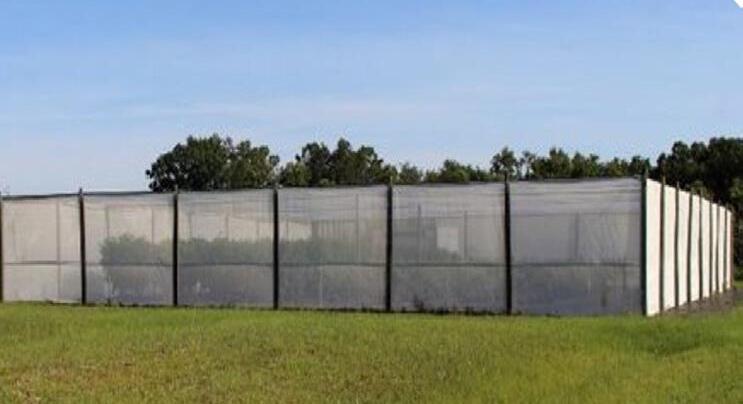
Summary:
The c itrus under protective screen (CUPS) is a novel production system implemented to grow citrus free of huanglongbing vectored by the Asian citrus psyllid. Other significant pests such as mites, scales, thrips, mealybugs, and leafminers, as well as parasitoids, and small predators have been identified from CUPS. Chrysomphalus aonidum (L.), an armored scale is a major pest of citrus. We determined the incidence of C. aonidum and parasitoid, Aphytis melinus in four-quarter acre CUPS structures and open-air (OA) controls planted with grapefruit (Citrus paradisi ). Temperature and humidity were higher in CUPS than in OA. Chrysomphalus aonidum was not found in OA plantings and was exclusively found in the in-
ground plantings in the CUPS, where 1112% trees were infested between two years of sampling cycles. The density of C. aonidum on the leaves increased significantly from 7.8 to 15.6 scales per cm2 from the first to second sampling cycle. Fruit infestation per infested tree averaged 18-24% with 3.1- 5.63 scales per cm2 Aphytis melinus was detected on the yellow sticky traps in CUPS and OA, and parasitized C. aonidum on leaves and fruit in the CUPS. Aphytis melinus captures were significantly higher in the CUPS than in OA and decreased with increasing temperature. The parasitism on leaves was remarkably higher than on fruit averaging 21% and 1.2%, respectively. Findings suggest the risk of C. aonidum infestation and prospects for biological control in CUPS.
Take Home Message:
• CUPS protects from ACP and HLB. However, mites, scales, thrips, mealybugs, and leafminers were identified.
• Findings of parasitoids and predators suggest potential for biological control.
• Monitoring is critical to identify pest problems and make informed management decisions.
Funding:
Individual Protective Covers
Researchers: Fernando Alferez, Ute Albrecht, Ozgur Batuman, Jawwad Qureshi, Saoussen Ben Abdallah
Contact: Fernando Alferez, UF/IFAS SWFREC
alferez@ufl.edu
Summary:
Individual protective covers (IPCs) are a strategy based on psyllid exclusion of individual trees using a protective mesh bag. IPCs can be installed on solid blocks of trees or in resets. IPCs are especially valuable for planting reset trees in gaps left by dead or removed trees in mature groves where huanglongbing (HLB) incidence is typically higher and the risk of infection is therefore greatest. IPCs should be placed immediately during planting to prevent any exposure of trees to the psyllids. In our research, we have found that IPCs effectively exclude psyllids, maintain trees free from HLB, and reduce canker incidence. We also found IPCs do not exclude all pests, and armyworms, black scale, mealybug, and
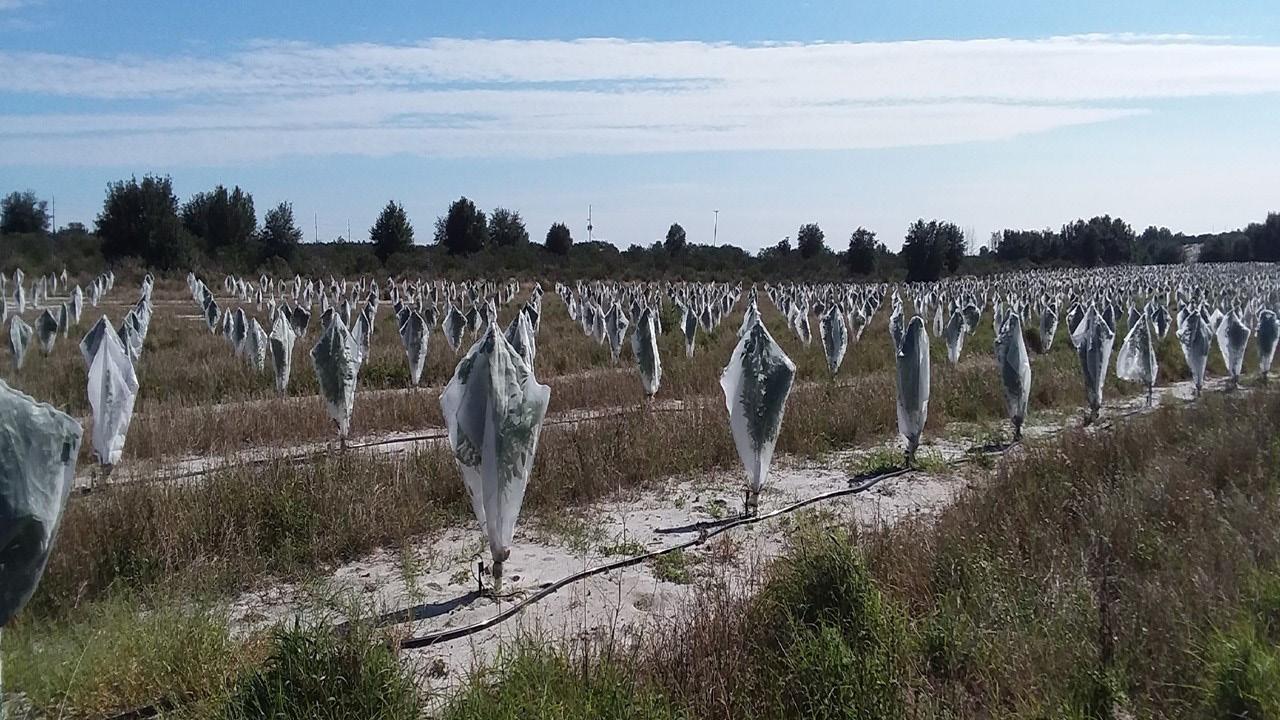
mites are often present. This means that regular scouting and insecticide application may still be necessary. Fruit from sweet orange varieties produced under IPCs have better internal quality and significantly more soluble solids (°Brix) than fruit from HLB-affected trees. Fruit quality is maintained at least for 2 years after IPC removal, even though trees become HLB-positive. We have tested the growth and physiology of different citrus varieties under IPCs. Our results show that sweet orange varieties (i.e, ‘Hamlin’ and ‘Valencia’), and some mandarins like ‘W. Murcott’ and ‘Tango’, as well as grapefruit, grow well under IPCs up to 3 years. Others like ‘Early Pride’ do not. Sugar Belle® mandarins grow well only for one year, with no additional benefit if IPCs are maintained for longer.
Take Home Message:
• IPCs exclude psyllids effectively in all citrus varieties tested, but other pests need regular monitoring and treatment.
• Fruit quality is greatly improved by IPCs.
• Not all citrus varieties respond equally to the IPCs.
Funding:
Recovering Huanglongbing-affected Young Citrus Trees
Researchers: Fernando Alferez, Saoussen Ben Abdallah, Osbaldo Vasquez
Contact: Fernando Alferez, UF/IFAS SWFREC
alferez@ufl.edu
Summary:
Adoption of individual protective covers (IPCs) does not occur in all groves, and in some cases, trees are still planted with no protection. Under these circumstances, if trees are left unprotected, they become infected with huanglongbing (HLB) during the first year, and they’ll never enter fruit production. We wondered if these trees could be recovered so they may become productive as they age. We know that treatment with brassinosteroids (Brs) may induce a strong immune response in young trees by activating the salicylic acid pathway. We hypothesized that infected young trees could be recovered by covering them with IPCs, so reinfection would not occur as the psyllids would be excluded, and by treating them with Brs, so an immune response would be
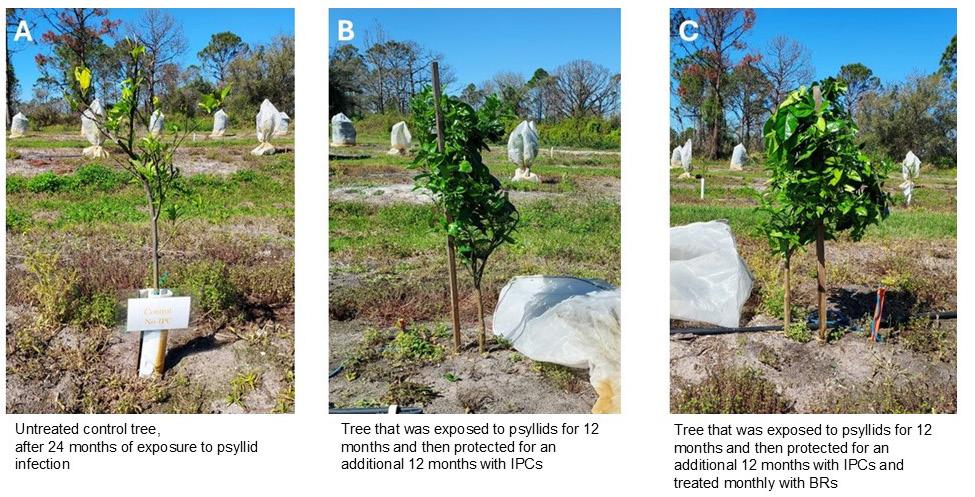
induced. We started a trial in February 2023. After one year, all trees tested positive for HLB and were declining. Then, in February 2024, one-third of the trees were covered with IPCs, and another third of the trees were covered with IPCs and received a monthly dose of Brs at a rate of 6.2 fl oz/100 gallons of water. The remaining third of the trees were left unprotected and not treated, so they served as the control trees. After one year, there was a clear recovery of the trees that were covered with IPCs, with better canopy density and larger leaves than the control trees. These effects were maximized in trees that were not only covered with IPCs but also treated with Brs. In this case, bacteria titer has been significantly reduced. We will continue monitoring the trees for at least one more year to determine if these changes are sustained over time.
Take Home Message:
• If unprotected at planting, trees become HLB positive in less than one year.
• Covering young, infected trees with IPCs can recover these trees; the effect is maximized if Brs are also applied.
• The combination of IPCs and Brs treatment reduces bacteria titer in young, infected trees.
Funding:
Life After Individual Protective Covers: Protecting New Flushes from Huanglongbing
Researchers: Ozgur Batuman, Lauren Fessler Mathews, Sanju Kunwar, Ana Redondo, Fernando Alferez
Contact: Ozgur Batuman, UF/IFAS SWFREC obatuman@ufl.edu
Summary:
Individual protective covers (IPCs) are proven effective in protecting young citrus trees from huanglongbing (HLB) by excluding Asian citrus psyllids (ACP). However, IPCs can be used only for 2-3 years after planting, depending on the citrus cultivar’s vigor and other horticultural traits. When IPCs are removed, trees become exposed to rapid ACP colonization and infection of C Las (2-3 months) in the grove. Similarly, the productivity of mature citrus trees unprotected from ACP feeding during the emergence of new flushes is dramatically reduced due to multiple reinfections. Therefore, citrus trees in HLB-endemic Florida conditions must be well protected from ACPs and reinfection after IPC removal, particularly when producing new flushes. To achieve this, we used the application of plant defense inducers, including brassinosteroids (Brs) and
Funding:

systemic acquired resistance inducers (SARs), to shield new growth from reinfection. We evaluated the efficacy of Brs and SARs in protecting young shoots emerging on trees treated with or without OTC-injection in the grove. Brs sprays were applied monthly, whereas SARs were only used once after the major flush cycle in May 2024. Three months after OTC injection and/ or three Brs or one SAR applications, qPCR results indicated significant C Las reduction in Brs- or SAR-treated trees, coupled with OTC injection, but not in non-injected trees. Field studies evaluating these approaches have demonstrated promising results. IPCs effectively block C Las infection, OTC reduces bacterial titers, while Brs and SARs protect new shoots from ACPmediated reinfections. Ongoing field trials aim to refine and integrate these tools into comprehensive integrated pest management (IPM) programs.
Take Home Message:
• SARs and Brs can protect young flushes from ACP-mediated C Las infection or reinfections.
• The use of SARs and Brs, along with other IPM tools (IPCs and OTC injections), can help sustain productivity.
• SARs tested are not available, but Brs are commercially available for growers for HLB management.
Combining Individual Protective Covers and Brassinosteroids to Prolong Young Citrus Tree Health
Researchers: Fernando Alferez, Ute Albrecht, Ozgur Batuman, Jawwad Qureshi, Saoussen Ben Abdallah
Contact: Fernando Alferez, UF/IFAS SWFREC
alferez@ufl.edu
Summary:
Individual protective covers (IPC), a type of psyllid exclusion mesh bag, are increasingly being adopted to efficiently protect newly planted citrus trees from huanglongbing (HLB) infection. However, IPCs typically must be removed after 2 to 3 years due to tree growth. Early evidence indicates that brassinosteroids (Brs), a relatively new class of plant hormones, delay HLB progression. With the aim of prolonging tree health after IPC removal, we are investigating the efficacy of Brs in protecting and/or preventing trees from Asian citrus psyllids (ACP) and

Candidatus Liberibacter asiaticus (C Las) infection once they are left exposed. Brs have been approved for commercial use in Florida citrus. Treatment with Brs prevented C Las infection 6 months after IPC removal. In contrast, 80% of the trees grown in IPCs without subsequent Brs treatments were HLB-affected at this time. After Brs treatment, trees flushed earlier and more synchronously and fruit set was 30% increased. In addition, we found less psyllids per flush. Canopy volume and tree height were significantly increased with Brs treatment after IPC removal. These results have been consistent for two seasons.
Take Home Message:
• Brassinosteroids delay HLB progression after IPC removal.
• Trees flush more profusely after Brs treatment once IPCs are removed.
• Psyllid population is reduced by Brs treatment.
Funding:
Brassinosteroids and Fruit Quality and Yield
Researchers: Fernando Alferez, Divya Aryal
Contact: Fernando Alferez, UF/IFAS SWFREC alferez@ufl.edu
Summary:
There are some indications that brassinosteroids (Brs) may advance commercial internal maturity by almost one month in ‘Valencia’ sweet orange, depending on the time of application. However, the best time of application in this variety and other sweet orange varieties like ‘Hamlin’, still needs to be determined, so this treatment can become economically feasible. We are working to determine how Brs treatment influences internal maturity in ‘Hamlin’ and ‘Valencia’ sweet orange varieties during fruit maturation, with the aim of finding the ideal maturation stage for applying the hormone and obtaining the best sugar-to-acid ratio. Our results for the first two seasons show that in ‘Hamlin’, Br application
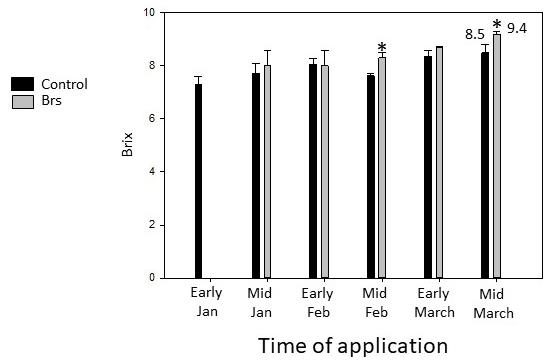
increased the sugar/acid ratio from 9 to 12 by early December on average. We also found a higher fructose content in juice from Brs-treated fruit. In ‘Valencia’ fruit, by harvesting in March, °Brix was increased by almost one degree unit. We also found that the health status of the tree determines the efficacy of Brs treatment. This means that the better health the tree shows, the better effect we get from the treatment. This past season we started treating with Brs trees that had been previously treated with oxytetracycline (OTC) injections. Our results this season confirm that in OTC-treated trees showing canopy recovery and better aspect, Brs may improve internal quality further, not only in terms of °Brix and ratio, but also in pound solids. Next season we will repeat treatments to confirm this result.
Take Home Message:
• Brs improve internal fruit quality by increasing the sugar/acid ratio in juice when applied close to harvesting.
• Brs induce the accumulation of certain sugars in the juice.
• Brs treatment is more effective in improving juice quality if trees were previously treated with OTC.
Funding:
Combining Horticultural Practices to Improve Yield of Huanglongbing-affected Citrus
Researchers: Tripti Vashisth
Contact:
Tripti Vashisth, UF/IFAS CREC
tvashisth@ufl.edu
Summary:
Water deficit has a strong impact on huanglongbing (HLB) affected citrus because of the severe damage to the root system the disease causes. Recent research has shown that more frequent daily irrigation (FI) during the dry spring period has a positive effect on final yield and canopy density compared to a standard irrigation program (SI) of two hours every other day. The positive impact that plant growth regulators (PGRs) have on HLB-affected citrus has also been shown in many other field trials, specifically the impact of the use of gibberellic acid (GA) for the improvement of canopy health. Using an already existing trial testing out FI, PGRs in combination with foliar nutrients were applied to a set of trees receiving the FI treatment. The
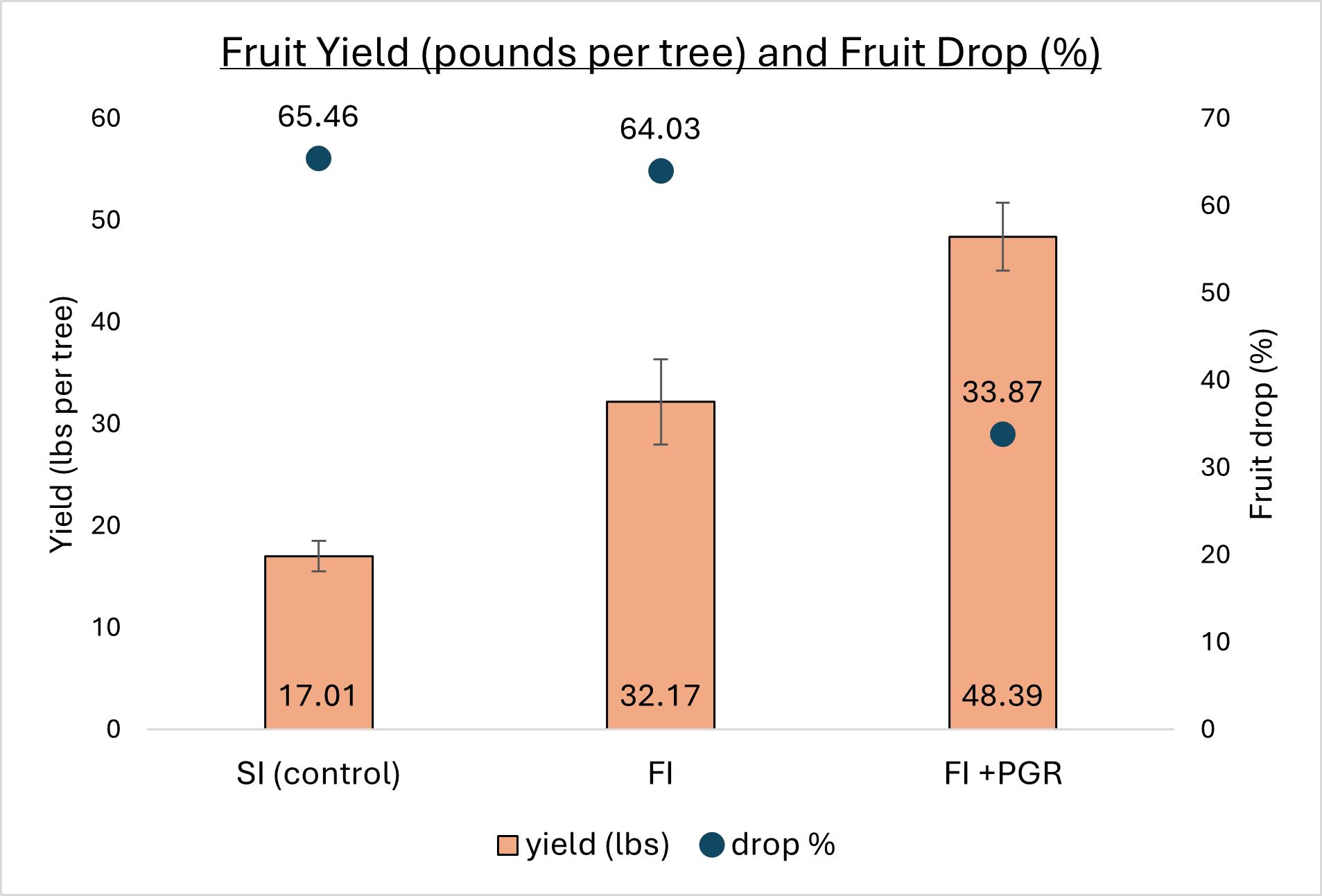
treatment contained cytokinin and calcium nitrate in the spring followed by GA, potassium, and micronutrients. Sprays were applied every 45 days from May until October. After one year of applications, the FI+PGR had significantly higher yield with an average of 48 pounds per tree which was significantly higher than the SI and FI treatments. FI+PGR also had significantly less fruit drop than SI and FI by an average of 30% as shown by the blue dots on the graph. Fruit quality was also trending higher in the FI+PGR treatment, probably due to the nutrients, which addresses some concern over PGRs reducing fruit quality. Combining enhanced horticultural practices, such as frequent irrigation and PGRs, can improve the yield and reduce fruit drop in HLBaffected citrus.
Take Home Message:
• Frequent irrigation + PGRs + nutrition can improve the yield and fruit quality of HLB-affected sweet oranges.
• The use of PGRs, when applied at the right time and rate, can increase yield and reduce fruit drop.
• Foliar nutrients such as potassium, alongside PGRs may contribute to improved fruit production.
Funding:
Keeping Cool with Particle Films
Researchers: Christopher Vincent
Contact: Christopher Vincent, UF/IFAS CREC
civince@ufl.edu
Summary:
Particle films have long been used to repel insect pests and enhance tree growth. Particle films are simply suspensions of solid particles that form a film over the surface of the leaf after they are sprayed and dried. They repel insects by reflecting different colors of light that keep the insect from identifying its host. They improve plant growth by dispersing light more evenly allowing leaves to stay cool and stomata to stay open for photosynthesis. Our research confirms that particle films can reduce psyllid pressure, delay huanglongbing (HLB) infection, and enhance growth in young trees. Dyeing the natural white color with red, improved psyllid control and moderately improved citrus growth over the white. The result was that by year three of a planting, particle film-treated trees produced three times greater yields than trees treated
Funding:

with foliar insecticides at least once per month. In the same year, fruit from particle film treated trees had 1 °Brix more than control trees. With detailed studies we saw that particle films improve leaf water status even when trees have enough soil water and that they reduce heat stress by keeping leaves about 10° cooler in the summer. We have found, though that in cooler weather (<70 °F) particle films can reduce photosynthesis, and high rates of particle films provide too much shading. While in moderate weather, low rates of particle films can improve water status, and in high summer temperatures higher rates are helpful. We are currently researching what rates are best for growth and yield. The best results we have obtained in bearing trees are with 12.5 lb per acre of Surround® WP, about 1/2 the labeled rate. We can retain the product on the tree by mixing it with a carnauba wax
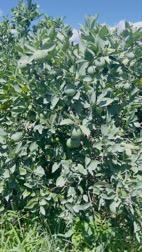
product. For now, we can conclude that particle films reduce Asian citrus psyllid (ACP) pressure; delay HLB infection; increase growth and yield, by reducing stress and improving tree water status; and the best choice of red versus white and rates may depend on the season.
Take Home Message:
Particle films increase growth by shading trees.
• Particle films are most beneficial in spring, summer, and fall, and probably not in winter.
• Rates of approximately 1/2 the labeled rate (12.5 lb/acre) are likely to be the most effective, and reapplication can be limited by including a carnauba wax product.
Applications of moderately high rates of red-dyed and natural white kaolin particle films on sweet orange trees.
Made in the Shade
Researchers: Christopher Vincent
Contact: Christopher Vincent, UF/IFAS CREC
civince@ufl.edu
Summary:
Mild shade reduces stress, increases growth and yield, and may improve pest management under huanglongbing (HLB). It reduces high temperature and water stresses. It may reduce HLB transmission by making the trees less attractive to Asian citrus psyllids (ACP). It also appears to reduce the severity of HLB symptoms in already infected trees. We began our research to test whether shade could be used horticulturally to reduce HLB transmission and severity in the field and improve yield. Shade reduced many symptoms of HLB in infected trees in the field. Under continuous 30% shade, trees produced more than two times the yields of full sun trees for three years, a dramatic increase in yield. Too much shade, though, (50% and
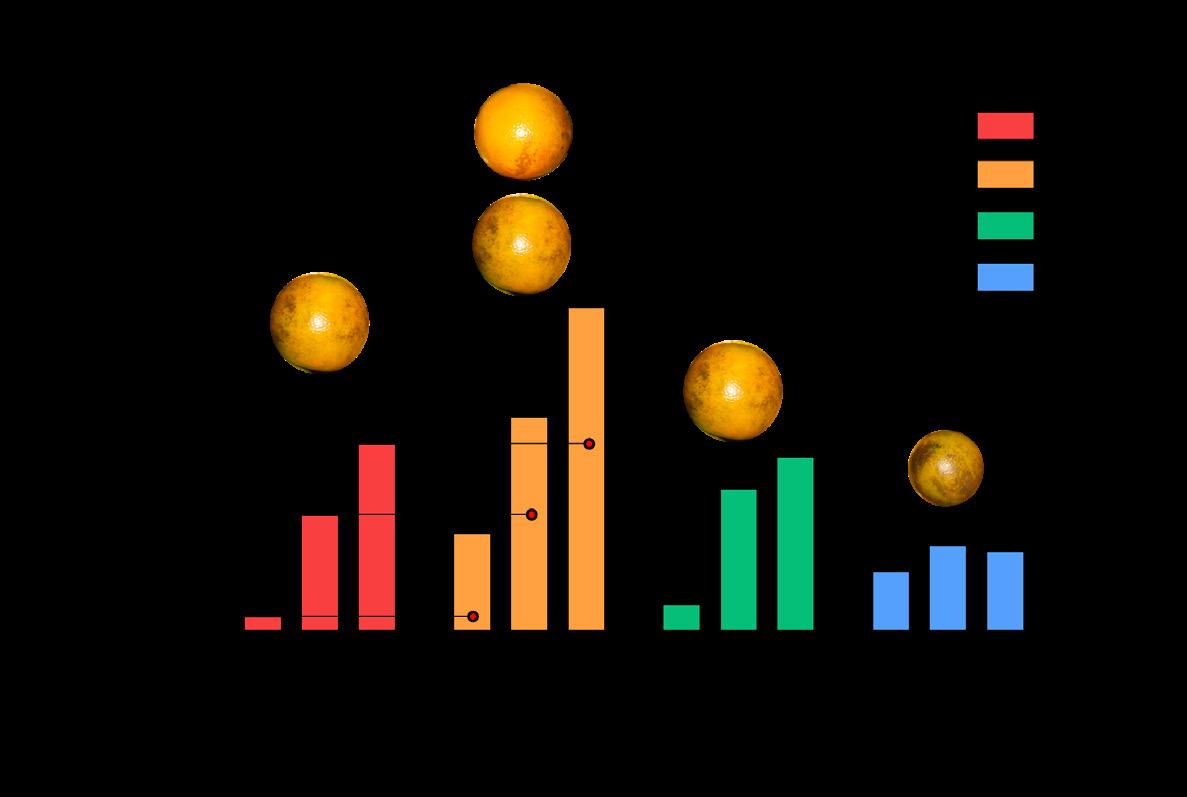
70% shade) reduced yields relative to the 30% level. Shade improved water relations and enhanced photosynthesis in HLB-positive trees. It also made trees more heat-tolerant. Overall, shade trees were less stressed and grew more than full-sun trees. This information may be used in the future to refine approaches that already use netting (CUPS, IPCs), to target rates of particle films (kaolin clay), and or directly shading in production systems. We are continuing work on this project to understand the impacts of shade on HLB transmission and to know whether the effects of shade on HLB-affected trees are different from shade’s effect on healthy trees. We are also looking at how to make shade via structures or other trees that have the best effects on citrus trees.
Take Home Message:
• Moderate shade improves health and mitigates the effects of HLB.
• HLB-positive trees under 30% shade consistently yielded more than 2 times those in the sun.
• Shade helps trees by reducing water deficit and heat stress.
Funding:
Understanding the Mechanism Behind Lower Fruit Drop and Enhanced Huanglongbing Tolerance in the ‘Parson Brown’
Researchers:
Manjul Dutt, Nabil Killiny, Tripti Vashisth, Lamiaa Mahmoud
Contact:
Manjul Dutt, UF/IFAS CREC manjul@ufl.edu
Summary:
The early-season ‘Parson Brown’ sweet orange demonstrates enhanced tolerance to huanglongbing (HLB). This tolerance enables ‘Parson Brown’ trees to produce healthier fruit even when infected with HLB. Furthermore, ‘Parson Brown’ oranges are known for their lower rates of fruit drop, a common issue with HLB-affected sweet oranges. Several factors, including reduced callose deposition and starch
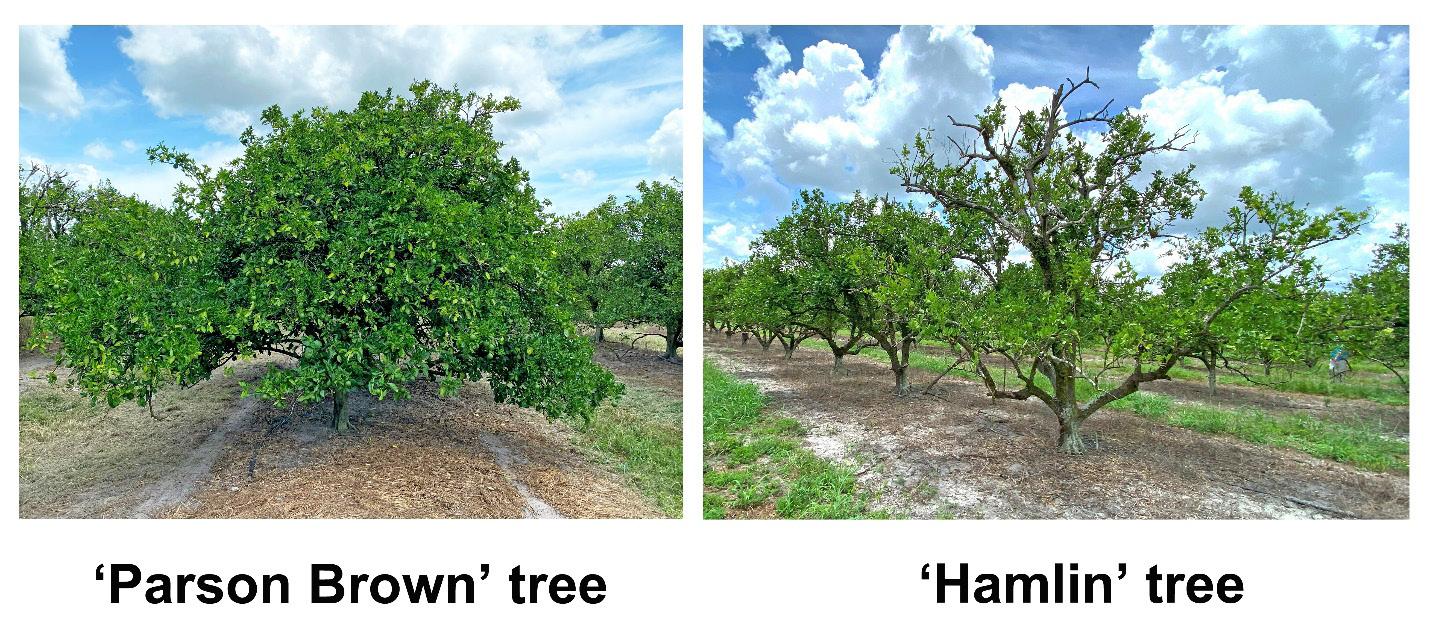
accumulation in ‘Parson Brown’, may play a role in this observed tolerance. Additionally, preliminary results from fruit detachment force analysis indicate that fruits from ‘Parson Brown’ trees have significantly higher fruit detachment force than ‘Hamlin’, resulting in better fruit retention and less fruit drop. This combination of HLB tolerance and reduced fruit loss makes the ‘Parson Brown’ a promising cultivar for growers facing the challenges of HLB.
Take Home Message:
• ‘Parson Brown’ sweet oranges are more tolerant to HLB than ‘Hamlin’.
• ‘Parson Brown’ sweet oranges can retain fruit on the tree significantly better than ‘Hamlin’ under endemic HLB.
Funding:
Developing Site-Specific Nitrogen and Phosphorus Rates for Florida Citrus
Researchers: Davie Kadyamopakeni, Muhammad Shahid, Lorenzo Rossi, Mark Ritenour, Kimberly Morgan, Alan Wright, Kelly Morgan, Mongi Zekri, Chris Oswalt, Danielle Williams
Contact: Davie Kadyamopakeni, UF/IFAS CREC
dkadyampakeni@ufl.edu
Summary:
Current citrus nutrient guidelines are based on studies of healthy citrus trees conducted in the pre-huanglongbing (HLB) era and may no longer be valid for the present situation, where 100% of mature citrus trees in Florida are HLB-affected. We propose to conduct research on different nitrogen (N) and phosphorus (P) rates for young/ mature citrus cultivars, including sweet oranges, grapefruits, and mandarins. Our project will evaluate 5 rates of N, namely 100, 150, 200, 250, and 300 pounds of N per acre per year and 5 rates of P at 0, 10, 20, 40, and 80 pounds of P2O5 per acre per year. These rates will address the objective of evaluating different levels of N and P in identifying the appropriate site-specific rate of N and P for HLB-affected citrus trees using site soil characteristics and

production practices to determine if we need to increase or decrease the current guidelines for N (200 lbs/acre) or P2O5 (15 lbs/acre). Using conventional and controlled-release fertilizer (CRF) fertilization sources, we should be able to develop and provide site-specific N and P guidelines for young and mature citrus trees of sweet oranges in central and southwest Florida, grapefruits in the Indian River district, and Satsuma mandarins in north Florida. Early results show no differences in fruit yield and juice quality, though nutrient levels appear more concentrated in the upper 6 inches compared to lower depths. Also, in Satsuma mandarins, high P levels have been observed in the panhandle. More data are being generated on water quality and canopy size. Optimal fertilizer rates should be determined in a few years.
Take Home Message:
• No differences fruit yield yet between N and P rates across sites.
• In Satsuma mandarins, high P levels have been observed in the panhandle.
• More data are being generated on economics and optimal fertilizer rates should be determined in a few years.
Funding:




Comparing Two New Nutrition Programs Utilizing Controlled-Release Fertilizer
Researchers:
Davie Kadyampakeni, Jude Grosser
Contact: Davie Kadyampakeni, UF/IFAS CREC
dkadyampakeni@ufl.edu
Summary:
Huanglongbing (HLB)-affected citrus trees in Florida exhibit severe deficiencies of all secondary and micronutrients (not NPK), especially in the roots. These deficiencies must be corrected to regain normal vascular system function as needed for high yields of quality fruit. Most grower practices to correct this problem provide oscillating levels of the affected nutrients, allowing trees to go below the required thresholds at different times of the year, apparently reducing tree performance. Simple increases in fertilization rates have also altered important NPK/secondary/ micronutrient ratios. We have also generated considerable evidence that continued use of controlled-release fertilizer (CRF) with coated secondary
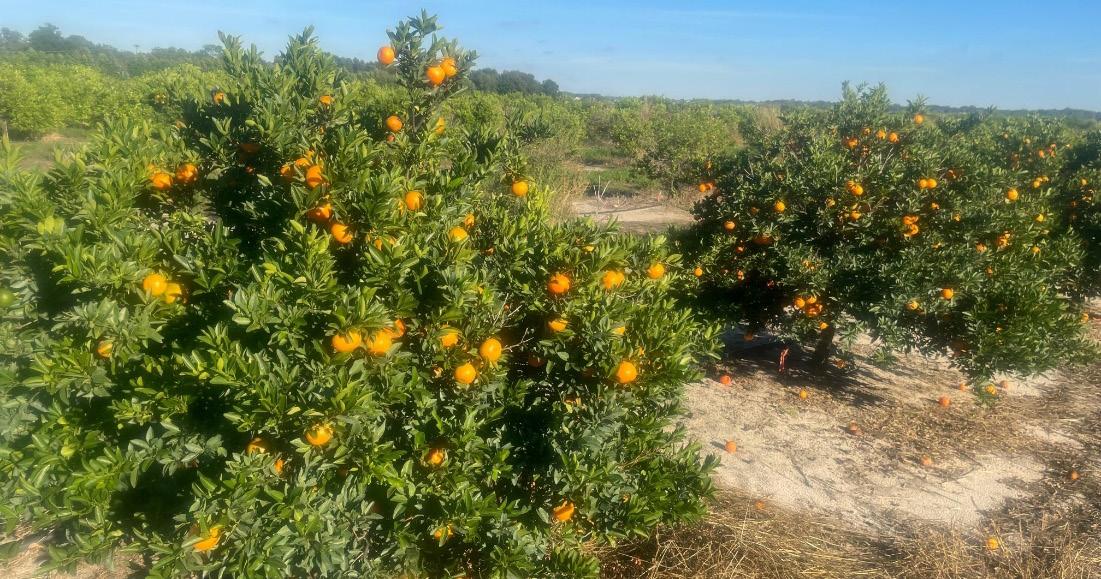
and micronutrients can stop fruit drop and produce pre-HLB quality fruit, regardless of rootstock. The project compares two new programs that are designed to provide a constant supply of elevated secondary and micronutrients to the roots year-long (mimicking real soil) to a selected standard commercial program.
The first program is a four soluble dry application program where the second and fourth applications are the complex mix containing CRF (5-1-7).
The second program is a four-time application soluble dry program, designed to test the Diamond R 5-15 CRF 180-day product along with a more affordable source of NPK. Both programs target 150 lbs. N/acre/year. The control standard nutrition program for comparison is a quarterly 180 lb N
program. Data collection on tree growth and soil nutrient variables for young trees and tree growth and fruit yield for bearing trees is underway and will be shared in due course.
Take Home Message:
• No differences have yet been observed in fruit yield and quality in bearing trees.
• Greater canopies observed in young trees receiving CRF and conventional blend.
• CRF would help offset the need for multiple fertilizations and help improve tree performance over time.
Funding:
Precision Nutrient Management to Rejuvenate Huanglongbing-affected Sweet Orange
Researchers: Tripti Vashisth
Contact: Tripti Vashisth, UF/IFAS CREC
tvashisth@ufl.edu
Summary:
Effective fertilizer management is critical for healthy tree growth and maximum yield. Historically, nutrient management for healthy citrus trees involved annual leaf sampling of 4-6-month-old spring leaves in July to August, with subsequent fertilization plans based on single nutrient analysis. The widespread prevalence of huanglongbing (HLB) in Florida needs improved approaches for fertilizer management through regular leaf sampling. Thus, this study was conducted to improve and revise leaf nutrient sampling guidelines for HLBaffected trees by optimizing sample collection methodologies and frequency per year. Emerging spring and summer flushes on mild and severe HLBsymptomatic ‘Hamlin’ and ‘Valencia’ trees were tagged in central Florida

for two consecutive years, with leaves sampled four times yearly for nutrient analysis. Two years of evaluation indicate that fertilization based on leaf nutrient analysis improved tree health and productivity with good canopy growth and less decline in both varieties of the HLB-affected trees. Spring leaf nutrient levels correlated to canopy density and yield. High leaf nitrogen and iron levels promoted tree canopy growth early in the season. Later in the year, leaf potassium and boron levels became more crucial for yield. Overall, this study shows that at least two leaf samples (June and September) are needed to improve the canopy and fruit growth of HLB-affected trees. Interestingly, a random leaf sample can also be collected, as a randomly collected leaf sample is comparable to the spring flush in June and September.
Take Home Message:
• Frequent fertilization based on frequent-timely leaf nutrient analysis can improve tree health and productivity.
• At least two leaf samples (June and September) are needed to adjust the fertilizer program to improve the canopy and fruit growth of HLBaffected trees.
• Spring leaf nutrient levels correlated to canopy density and yield, and random leaf samples can also be collected.
Funding:
The
The Impact of Organic Acids on Soil Health and Acidification
Researchers: Davie Kadyampakeni, Tripti Vashisth
Contact: Davie Kadyampakeni, UF/IFAS CREC
dkadyampakeni@ufl.edu
Summary:
We conducted an experiment for 4.5 years to determine the effects of soil amendments on soil pH. We compared the impacts of fulvic acid, humic acid, and sulfuric acid with and without elemental sulfur. We tracked and analyzed canopy size, fruit yield, fruit quality, soil nutrient availability, leaf nutrient levels, and root density in the field. Moderate acidity (5.56.5) promoted nutrient availability compared to pH greater than 7.5. There was a positive correlation between soil pH and soil calcium (Ca), magnesium (Mg), zinc (Zn), manganese (Mn), and boron (B), possibly suggesting that the availability of these soil nutrients increased as pH increased. A negative
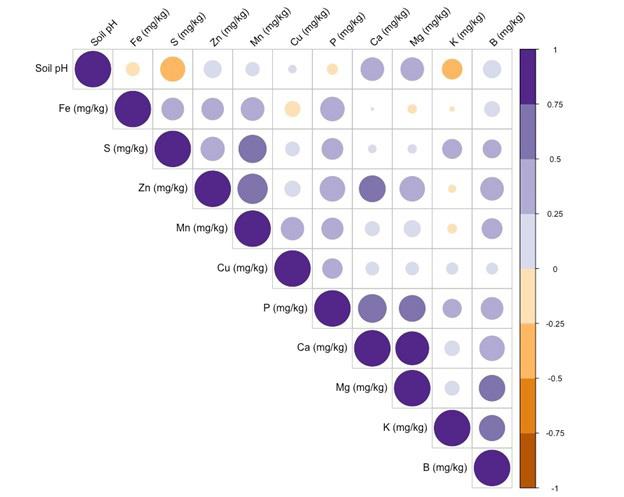
correlation was observed between soil pH and soil iron (Fe), sulfur (S), potassium (K), and phosphorus (P), indicating decreased nutrients in soil solution as pH increased. Fulvic acid + elemental sulfur had increased the root density, while humic acid + elemental S showed a significantly lower root density. Use of organic acids such as humic acid and fulvic acid should be considered for lowering soil pH along with elemental sulfur. Combined use of organic acids and elemental sulfur increased nutrient availability on Florida sandy soils, though fruit yields and fruit quality were comparable between treatments over the four years.
Take Home Message:
• Fulvic acid + elemental sulfur had increased the root density, while humic acid + elemental S showed a significantly lower root density.
• A negative correlation was observed between soil pH and soil iron (Fe), sulfur (S), potassium (K), and phosphorus (P), indicating decreased nutrients in soil solution as pH increased.
• Use of organic acids such as humic acid and fulvic acid should be considered for lowering soil pH along with elemental sulfur.
Funding:
Assessing the Therapeutic Effects of Soil Amendments
Researchers: Davie Kadyampakeni
Contact: Davie Kadyampakeni, UF/IFAS CREC
Summary:
Huanglongbing (HLB) poses a critical threat to citrus production in the United States by impairing root function, reducing fruit yields, resulting in tree decline. Current management strategies rely on unsustainable synthetic fertilizers and chemical inputs, contributing to soil degradation, reduced microbial diversity, and escalating production costs. This project proposes soilcentered, ecological strategies utilizing organic amendments and beneficial microbes to improve soil health, root development, and fruit productivity in citrus production systems impacted by huanglongbing. The project is being conducted at four commercial citrus sites (four in Florida and two in Texas) using a randomized complete block design testing five treatments combining organic amendments
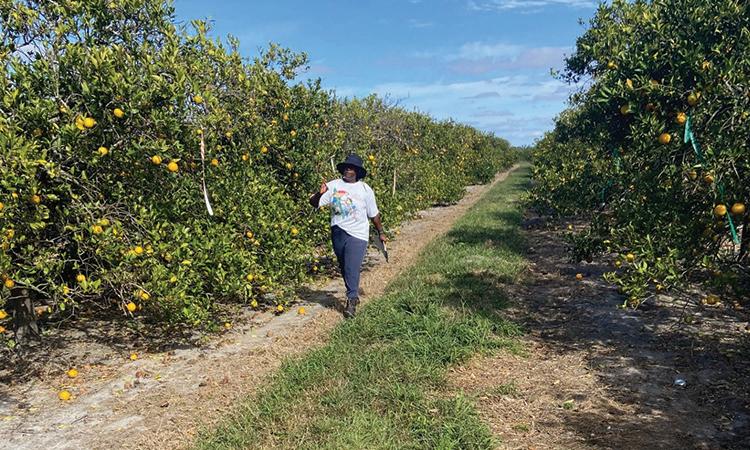
and beneficial microbes. We are evaluating critical components: soil health indicators measuring physical, chemical, and biological indicators; root density and distribution; and fruit yield, quality, and drop rates. Beneficial microbes are applied with organic amendments to enhance nutrient cycling and microbial activity, promoting root development and root-soil interactions. This project addresses critical knowledge gaps on the role of microbial and organicbased practices in rehabilitating citrus groves affected by HLB. Focusing on the soil-plant interface, the project seeks to improve nutrient and water effciency and enhance environmental resilience. Grower collaboration through the six on-farm trials, outreach, and knowledge-sharing is emphasized to support the widespread adoption of sustainable practices. Results will be
disseminated through grower meetings, fact sheets, grower workshops, and conferences. This project aligns with sustainable agriculture principles, supporting productivity, environmental stewardship, and the long-term viability of citrus production systems.
Take Home Message:
• The project is evaluating the impact of various organic amendments and beneficial microbes on nutrient cycling and fruit yield.
• The results are expected to improve root and soil health and long-term and sustainable citrus production.
• Environmental quality is also expected to improve due to use of soil amendments and reduced use of synthetic fertilizers.
Funding:
Improving Soil Health with Cover Crops and Other Soil Amendments in Florida Citrus Groves
Researchers: Sarah Strauss, Emma Dawson, Gabriel Pugina, Brittney Monus, Ute Albrecht, Ramdas Kanissery
Contact: Sarah Strauss, UF/IFAS SWFREC
strauss@ufl.edu
Summary:
Healthy soils can sustain biological productivity, maintain environmental quality, and promote plant health. One strategy to boost Florida soil health is through increasing soil organic matter (SOM). Planting cover crops (CC) or applying compost or humic acids could enhance SOM and soil health. We are examining the impact of these three methods in commercial Florida citrus groves and at the UF/IFAS Southwest Florida Research and Education Center. All trials include a no-treatment/grower standard control and either CCs in the row middles, or compost or humic acids broadcast around the trunk. Planting mixtures of legume and non-legume CC in Flatwood groves altered the soil microbial composition and nitrogen availability, as well as increasing SOM. Yield and °Brix also significantly

increased in one Flatwood grove after three years of CCs. However, CCs in a grove on the Ridge had no significant impact on the trees, soil nutrients or microbes after three years. Applying compost around trees in the Flatwoods significantly changed the soil microbial activity and some nutrients, and changes depended on the rootstock variety. However, humic acids had no significant impact on soil microbes, nutrients, or tree growth. Overall, our results suggest: 1) CC and compost improvements in SOM, nutrient cycling, and microbial composition in citrus row middles can be observed during the first three years of treatment but results depend on location and management of the grove, and 2) humic acids had little impact on trees or soil microbes and nutrients. Increasing SOM and soil health is a long-term process, so trials are still ongoing.
Take Home Message:
• Cover crops can change soil organic matter, soil microbial community, and their functions.
• The magnitude of cover crop changes can depend on the grove location, management, and establishment of cover crops.
• Compost can also alter soil organic matter, microbes, and nutrients, but humic acids had little effect on these properties.
Funding:
Measuring Soil Health in Florida Citrus Groves
Researchers: Sarah Strauss, Yaslin Gonzalez, Adesuwa Erhunmwunse, Elena Karlsen-Ayala, Brittney Monus, Gabriel Maltais-Landry
Contact: Sarah Strauss, UF/IFAS SWFREC
strauss@ufl.edu
Summary:
Soil health, similar to soil quality, is not a new concept, but it is receiving increased attention because of its impact on crop production. Healthy soils have greater water-holding capacity, nutrient availability, and microbial activity, all of which can impact root growth and nutrient uptake. Several management practices are associated with soil health improvements, including cover cropping and compost. To assess changes in soil health, measurements can be made of different indicators. However, over 20 indicators can be used to measure soil health, ranging from relatively simple measurements of soil pH to more complicated measurements of soil microbes. Most research on soil health indicators has been conducted in annual crops and soils that are very different from Florida citrus systems,
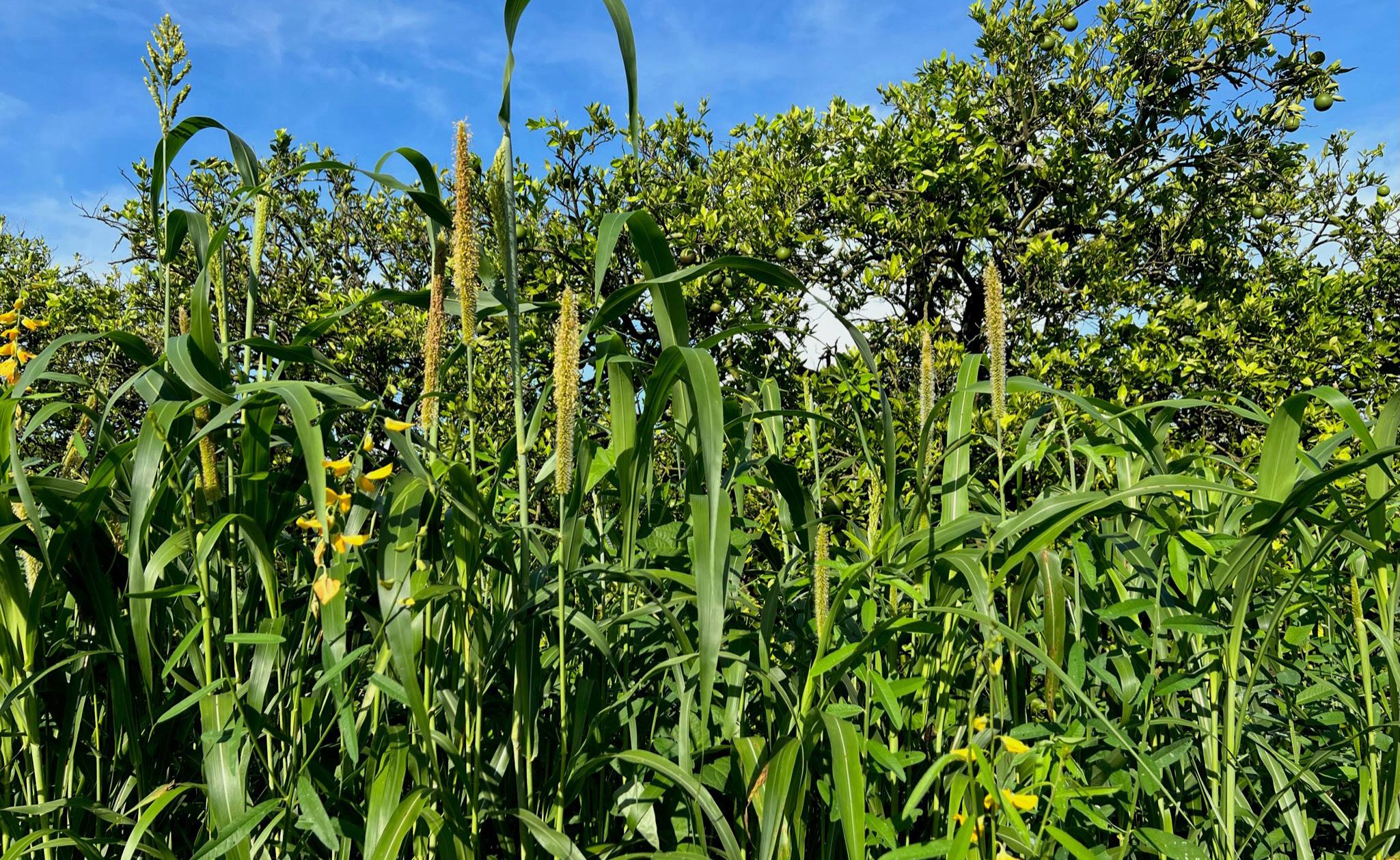
and not all soil health indicators may be appropriate for our Florida systems. Therefore, we are conducting a farmscale study to identify indicators that will provide short-term (months) and long-term (years) assessments of changes to soil health in Florida citrus groves. Preliminary results found soil organic matter (long-term indicator), carbon mineralization (short-term indicator), and permanganate oxidizable carbon (short-term indicator) indicated changes in soil carbon with the use of a management practice intended to improve soil health. Soil protein and carbon mineralization were also predictors of fruit yield and juice quality at one grove, illustrating the important role soil health can play in tree production. This study is ongoing as we hope to provide information to growers on how these indicators can provide inform management of soil health and production.
Take Home Message:
• The sandy sub-tropical soil of Florida requires calibration and assessment of soil health indicators, as most previous soil health indicator work has been conducted in other parts and different agricultural systems of the United States.
• There is a wide range of indicators that can be used to measure soil health, but variations in methodology can make comparisons difficult.
• Measurements of soil carbon appear to be good indicators of soil health for Florida citrus groves.
Funding:
Herbicides and Huanglongbing: Assessing Indaziflam Use in Florida’s Citrus Groves
Researchers: Ramdas Kanissery, Nirmal Timilisina, Ozgur Batuman
Contact: Ramdas Kanissery, UF/IFAS SWFREC
rkanissery@ufl.edu
Summary:
To address the challenges of huanglongbing (HLB), Florida citrus growers have implemented enhanced nutrition and irrigation strategies to support tree health and sustain yields. While these practices are beneficial, they also encourage weed growth, leading to increased reliance on herbicides. This has raised concerns about the potential non-target effects of certain herbicides on HLB-affected trees, which are already prone to reduced root growth and higher rates of pre-harvest fruit drop. This study investigated the potential impacts of indaziflam, a widely used preemergence herbicide and the active ingredient in Alion®, on root growth, HLB disease severity, and fruit detachment force in two key juice citrus cultivars, ‘Hamlin’ and ‘Valencia’. The research

was conducted in two commercial groves in southwest Florida and included three application rates of indaziflam (low, medium, and high), all within the approved use range for citrus. These treatments were compared to herbicide untreated and weedfree controls, with all plots managed under standard grower practices. Results showed that indaziflam did not significantly affect root growth, disease severity, or fruit detachment force at either location. These findings suggest that, under the conditions tested, indaziflam does not negatively impact root development or worsen HLB-related symptoms. However, given the herbicide’s widespread use in Florida citrus production, continued long-term research is required to better understand its potential non-target effects in citrus groves.
Take Home Message:
• Indaziflam showed no harmful effects on root growth or fruit detachment in HLB-affected citrus.
• No increase in HLB severity was observed with indaziflam use.
• Ongoing research is important to confirm the long-term safety of repeated indaziflam use.
Funding:
Periodic root imaging conducted using minirhizotrons installed in citrus trees from indaziflam-treated plots, with comparisons made to root images from trees in untreated and weed-free control plots.
Greener and Cleaner Row-Middles: Using Cover Crops for Sustainable Weed Control in Citrus
Researchers: Ramdas Kanissery, Miurel Brewer, Davie Kadyampakeni, Sarah Strauss
Contact: Ramdas Kanissery, UF/IFAS SWFREC rkanissery@ufl.edu
Summary:
A multi-year study conducted in two commercial citrus groves in southwest Florida assessed the use of cover crops as a sustainable alternative to conventional vegetation management in citrus row middles. The study compared two cover crop (CC) mixtures: one combining legume and non-legume species, and another with non-legume species only, against a grower standard management (GSM) approach that used mowing and herbicide applications for weed control. Key measurements included cover crop biomass as well as weed density and biomass during both spring and summer/fall planting seasons. Results showed that both CC mixes significantly reduced weed density by 58% to 99% and weed biomass by 95% to 99% compared

Funding:
to the GSM system. These findings highlight the effectiveness of cover crops in suppressing weed growth in citrus row middles. There were no significant differences in weed suppression between the two CC mixes, indicating that growers can select either mix based on seed availability, cost, or other agronomic considerations. However, weed control varied between growing seasons, primarily due to differences in the germination and establishment of the cover crops, emphasizing the importance of optimal planting timing and favorable environmental conditions. Overall, the study demonstrates that cover cropping can serve as an effective and environmentally friendly weed management strategy in Florida citrus groves.
Take Home Message:
• Cover crops reduce weed pressure in citrus row middles, offering a sustainable alternative to mowing and herbicides.
• Legume/non-legume and nonlegume-only mixes suppressed weeds equally, offering growers flexibility in CC mix choice.
• Successful weed control requires good CC establishment; proper planting time and favorable weather are key factors.
Comparison of citrus row-middles without cover crops (left) and with cover crops (right). Cover crops, such as Daikon radish, effectively suppressed weed emergence and growth, particularly black nightshade, Carolina geranium, and Guinea grass, highlighting their potential as a sustainable weed management strategy in citrus production systems.
Recovering from Hurricanes
Researchers: Christopher Vincent, Tripti Vashisth
Contact: Christopher Vincent, UF/IFAS CREC
civince@ufl.edu
Summary:
Recent hurricanes have harmed citrus trees in much of Florida, especially in the sweet orange growing areas. Reports from growers suggest that trees take a long time to recover from hurricanes. We began this project to describe the recovery process as well as to document what grower practices protected trees from damage or helped trees recover more quickly. We observed that trees exposed to Category 1 winds showed less defoliation initially, but the leaves were more stressed during the dry season. We have measured that hurricanes limited the branches’ capacity to move water to the leaves for at least 6 months after a category 1 storm,

though the effect of category 3 winds is greater. Stronger winds showed more immediate damage, but less stress to new leaves in the dry season, because the less canopy requires less water. Leaf health recovered during the rainy season, while canopy recovery was slower. Canopy loss was still evident more than 15 months later in trees that had greater than 75 mph winds during Hurricane Ian. Gibberellic acid (GA) applications provided some protection from Category 1 wind damage. Because of the effects of the hurricane on tree water transport capacity, treatments that improve water availability (frequent irrigation, particle film application) are most likely to hasten recovery. We continue to follow up on trees after Hurricane Milton.
Take Home Message:
• Hurricanes impact trees through both defoliation and damage to the xylem capacity to move water.
• Even trees with little obvious damage are stressed by dry and hot conditions in the following year.
• Preventing high winds and GA can help prevent damage beforehand, while frequent irrigation and particle films can improve health during the recovery period.
Funding:
Agroview: AI-Driven Citrus Analytics at Scale
Researchers: Yiannis Ampatzidis
Contact: Yiannis Ampatzidis, UF/IFAS SWFREC
i.ampatzidis@ufl.edu
Summary:
Agroview (agintel.ai), a patented (U.S. Patent No. 12,008,730, issued June 11, 2024), cloud-based, and AI-powered platform, can be used for processing, analyzing, and visualizing data collected from aerial (e.g., UAVs, airplanes, satellites) and groundbased (e.g., smart sprayers) sensing systems. Agroview is actively used by specialty crop growers, consulting firms, and crop insurance providers to monitor field conditions and make informed, data-driven, and plantbased decisions (video demos: (1) tinyurl.com/2uurssrh; (2) tinyurl. com/38f37t59). In 2020, Agriculture Intelligence Inc.
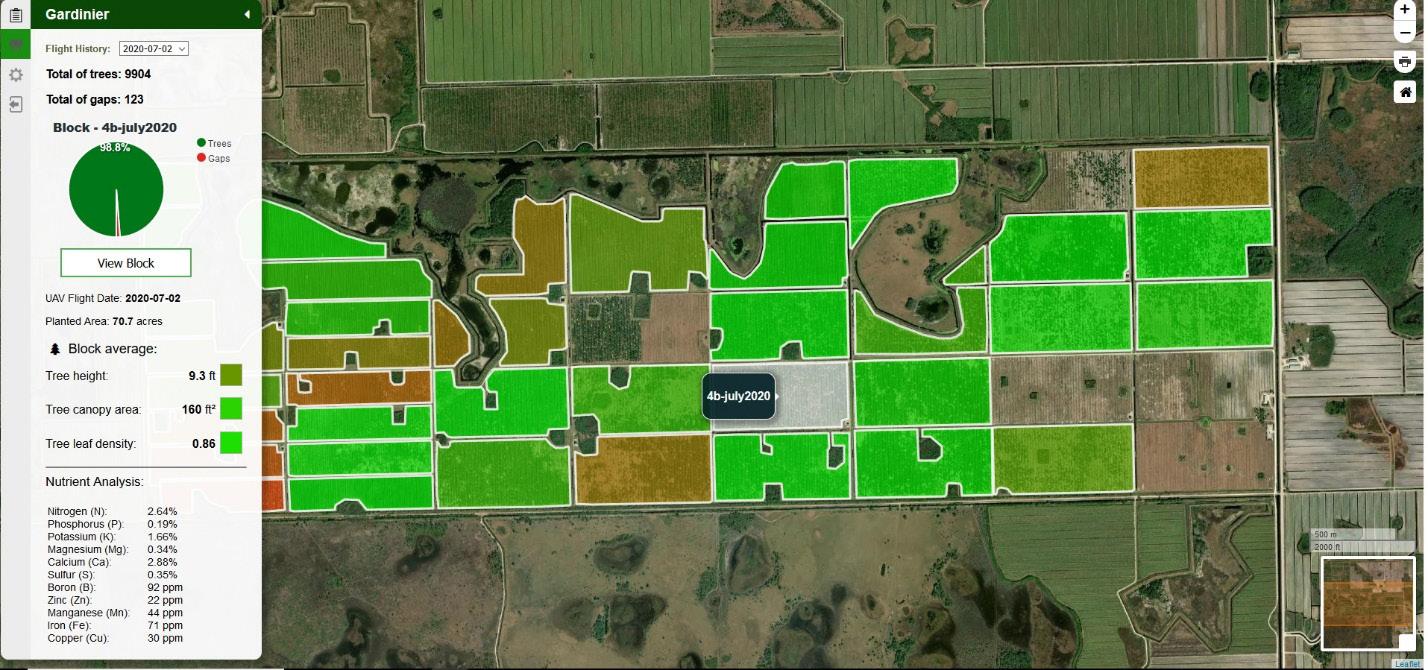
(agintel.ai), a University of Florida spinoff company, licensed and commercialized the technology. Since then, Agroview has been deployed across more than 100,000 acres of citrus in Florida, demonstrating its scalability and real-world impact. Compared to traditional manual methods for collecting tree inventories, estimating plant nutrient levels, and predicting yield, Agroview significantly reduces both time and cost, by as much as 90% in some cases. The platform also supports rapid post-disaster crop damage assessments (e.g., after hurricanes), offering a critical tool for enhancing agricultural resilience and recovery.
Take Home Message:
• Agroview enables fast, accurate, and affordable citrus analytics using AI and remote sensing.
• The platform is commercially deployed across 100,000+ acres, proving its scalability and value.
• It supports rapid post-disaster assessments, enhancing resilience in citrus production.
Funding:




Insuring the Crop Using Actual Production History
Researchers: Ariel Singerman
Contact: Ariel Singerman, UF/IFAS CREC
singerman@ufl.edu
Summary:
Obtaining coverage under the Actual Production History (APH) crop insurance policy has been, on average, economically beneficial for Florida citrus growers so far. This is because the policy provides coverage against yield losses based on historical farm yield records, which leads to higher guarantees relative to those that would result if the downward trend in yield caused by HLB was accounted for. It is important to note, however, that net payouts from APH are, on average, decreasing over time because the premium rates are increasing and yield as well the APH yield are decreasing. Thus, going forward, growers should consider two important factors when

choosing to insure their crops under such a policy. First, to be eligible for APH coverage, a block that is at least eight years old must have produced at least 100 boxes per acre in one of the three most recent seasons. Even when a special request is made to insure such a block, the determined yield may not exceed 80% of the average yield for the entire APH database. Second, APH standards include a procedure for testing high variability in yield due to a downward trend pattern in the APH database. If the test for such a pattern is positive, the APH yield will be reduced by 20%. Therefore, individual growers may want to make their own calculations to determine the optimal level of APH coverage for their groves.
Take Home Message:
• Net payouts from APH are, on average, decreasing over time.
• Yield for a block that is eight years old or older needs to be at least 100 boxes per acre to be insurable under APH.
• When the APH downward trend adjustment is implemented, the APH yield will be reduced by 20%.
Funding:
REON: A Web-Based Platform for Actionable Huanglongbing Research
Researchers: Megan Dewdney, Neil McRoberts, Mike Hill, Tolulope Agunbiade, Sebastian Galindo, Lauren Diepenbrock, Tripti Vashisth, Yu Wang
Contact: Megan Dewdney, UF/IFAS CREC
mmdewdney@ufl.edu
Summary:
Huanglongbing (HLB) continues to threaten citrus production in the United States, particularly in Florida, Texas, and California. Although substantial research has been conducted to understand and manage the disease, the resulting information is often fragmented, highly technical, and not easily accessible to growers or other stakeholders. This disconnect makes it difficult for the citrus industry to practically apply research findings and to make informed, science-based decisions. To address this challenge, REON (Research and Extension Output Network) is creating a centralized, web-based platform that compiles and organizes USDA-funded HLB research. The first phase of the project involves identifying and analyzing the outputs of USDA-funded grants. Initial findings indicate a strong focus on long-term, theoretical research,
Funding:
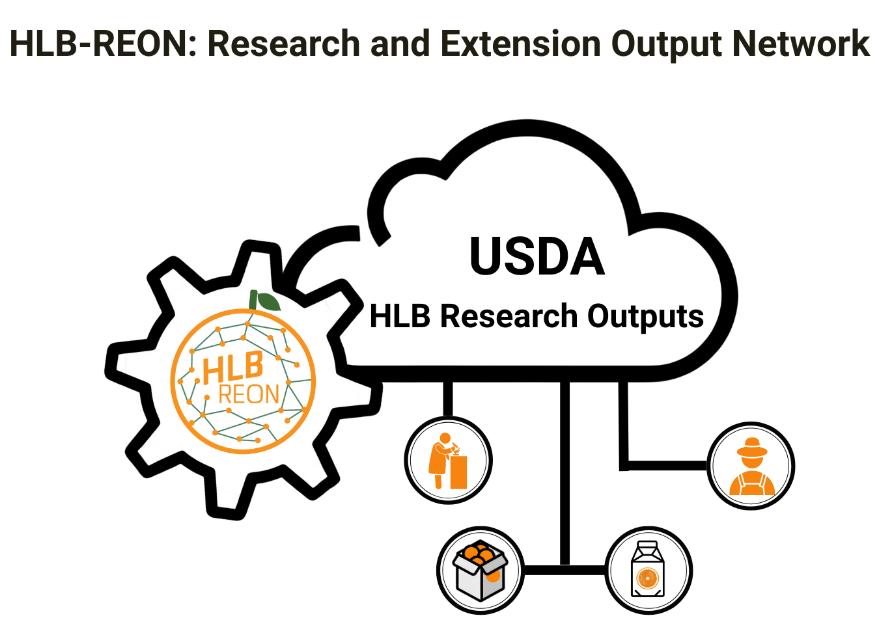
with less emphasis placed on short term, practical solutions such as antimicrobial treatments and nutritional management strategies. At the same time, a grower advisory committee, from Florida, Texas, and California, is involved in shaping the platform to ensure it is useful, relevant, and aligned with growers’ needs. The final product will include both technical research and practical summaries, along with Extension materials designed to support real-world decision making. By making HLB research more transparent, accessible, and actionable, REON aims to support the entire citrus community. This initiative will help growers and other stakeholders develop effective, science-based strategies to manage HLB and build resilience in the face of ongoing challenges. Interested in the project? Contact Ulianova VidalGomez at vidalgomezu@ufl.edu. Your input is key!
Take Home Message:
• REON is building a web platform to centralize USDA-funded HLB research.
• Most research focuses on long-term solutions; practical tools are limited.
• Growers help guide the project to ensure it meets real-world needs.


UF/IFAS Citrus REC
@UF IFAS Citrus Research and Education Center
@UFIFASCitrusREC
@ufifascitrusrec
UF/IFAS Citrus REC
UF/IFAS Indian River REC
@University of Florida/ IFAS Indian River Research and Education Center
@UFIFAS_IRREC
@UF_IFAS_IRREC
UF/IFAS North Florida REC UF/IFAS Southwest Florida REC
@UF IFAS North Florida Research and Education Center (NFREC)
@UF/IFAS-Southwest Florida Research & Education Center
@ufifasnfrec @SWFREC
@uf_ifas_nfrec
uffortpierce SWFREC
ALL INfor Citrus Podcast
Listen to the All in for Citrus podcast, a monthly podcast produced in collaboration with AgNet Media/Citrus Industry and featuring UF/IFAS researchers and citrus experts sharing the latest news about growing citrus in Florida. Listen and learn more at All In For Citrus Podcast.
Name..............................................................
Page Numbers
Abdallah, Saoussen Ben 46, 47, 49
Agunbiade, Tolulope 67
Albrecht, Ute 27, 32, 33, 34, 35, 38, 42, 46, 49, 60
Alferez, Fernando 24, 27, 38, 42, 46, 47, 48, 49, 50
Al-Shami, Salman 45
Amon, Kelvin 38
Amoretti, Diego Salazar 28
Ampatzidis, Yiannis 27, 38, 42, 65
Ancona, Veronica 38
Aryal, Divya ..................................................................................... 50
Batuman, Ozgur 4, 14, 16, 27, 31, 36, 37, 38, 42, 46, 48, 49, 62
Bonning, Bryony 20
Borneman, James ......................................................................... 17
Brewer, Miurel 63
Brown, Judith 25
Brunet, Stephane 31
Cano, Liliana 29
Carvalho, Deived 32
Chase, Christine 9
Chater, John 6, 12, 13
Chen, Xuedong 23, 24
Dawson, Emma 60
Dewdney, Megan ........................................... 28, 29, 30, 43, 44, 67
Diepenbrock, Lauren 14, 21, 22, 39, 43, 44, 67
Dufour, Jeremy 31
Duncan, Larry ................................................................................. 21
Dutt, Manjul 5, 6, 8, 11, 14, 15, 18, 19, 20, 54
El Mohtar, Choaa 4, 17, 18, 19
England, Gary 5
Erhunmwunse, Adesuwa 61
Freitas, Jasmine 32
Galindo, Sebastian 67
Gautam, Sandipa 41
Gmitter, Fred 9, 12, 13
Gonzalez, Yaslin 61
Graham, Jim 9
Grosser, Jude 6, 7, 8, 9, 11, 12, 13, 14, 56 Guo, Zhongwu 41
Hill, Mike ......................................................................................... 67
Jayachandran, Krish 28
Kadyampakeni, Davie 55, 56, 58, 59, 63
Kanissery, Ramdas ........................................................... 60, 62, 63
Karlsen-Ayala, Elena 61
Killiny, Nabil 6, 11, 14, 20, 38, 40, 54
Knobloch, Thomas 31
Kunwar, Sanju 27, 36, 37, 48
Levy, Amit 4, 19, 38, 40, 41
Mahmoud, Lamiaa 6, 54
Maltais-Landry, Gabriel 61
Mandadi, Kranthi 17, 28, 41
Manker, Denise 31
Name..............................................................
Page Numbers
Martinez, Izabella 39
Martini, Xavier 23
Matthews, Lauren Fessler 27, 36, 37, 48
McRoberts, Neil 67
Mondal, Mosharrof 25
Monus, Brittney 60, 61
Moreno, Gerardo 32
Morgan, Kelly 55
Morgan, Kimberly 55
Mou, Zhonglin ..................................................................... 4, 16, 19
Murata, Mayara 9
Nawaz, Kiran 25
Nunes, Larissa ........................................................................ 32, 34
Omar, Ahmad 7, 9
Oswalt, Chris 55
Paredes-Montero, Jorge 25
Pelz-Stelinski, Kirsten 39
Pugina, Gabriel 32, 34, 35, 60
Quinn, Nicole 22
Qureshi, Jawwad
23, 24, 25, 26, 45, 46, 49
Ramekar, Sheetal 5
Redondo, Ana 27, 36, 37, 48
Rezazadeh, Amir ............................................................................ 28
Ritenour, Mark 29, 45, 55
Rodrigues, Igor 32, 34
Roldan, Erik .................................................................................... 39
Rossi, Lorenzo 55
Saberi, Esmaeil 25
Schumann, Arnold 45
Seymour, Danelle 4
Shahid, Muhammad 55
Shetty, Kateel 28
Singerman, Ariel 66
Stelinski, Lukasz 20, 21, 23, 39
Strauss, Sarah 60, 61, 63
Tardivo, Caroline 32
Telg, Ricky 16
Timilisina, Nirmal 62
Triplett, Eric .................................................................................... 16
Tsatsu, Seth 26
Vashisth, Tripti 41, 51, 54, 57, 58, 64, 67
Vasquez, Osbaldo .......................................................................... 47
Vincent, Christopher 40, 41, 52, 53, 64
Wade, Tara 38, 42
Wang, Nian 7, 19
Wang, Yu 67
Williams, Danielle 55
Wright, Alan 55
Xu, Shouling 16
Zambon, Flavia Tabay 9, 10
Zekri, Mongi 55
Contacts
CREC
Michael Rogers (Center Director) mrgrs@ufl.edu (863) 956-5899
John Chater jchater@ufl.edu (863) 956-8662
Michelle Danyluk mddanyluk@ufl.edu (863) 956-8654
Megan M. Dewdney mmdewdney@ufl.edu (863) 956-8651
Lauren Diepenbrock ldiepenbrock@ufl.edu (863) 956-8801
Larry Duncan lwduncan@ufl.edu (863) 956-8821
Manjul Dutt manjul@ufl.edu (863) 965-8679
Choaa El Mohtar mohtarc@ufl.edu (863) 956-8720
Fred Gmitter fgmitter@ufl.edu (863) 956-8878
Jude Grosser jgrosser@ufl.edu (863) 956-8680
Davie Kadyampakeni dkadyampakeni@ufl.edu (863) 956-8843
Nabil Killiny nabilkilliny@ufl.edu (863) 956-8833
Amit Levy amitlevy@ufl.edu (863) 956-8704
Ahmad Omar omar71@ufl.edu (863) 956-8678
Arnold Schumann schumaw@ufl.edu (863) 956-8855
Ariel Singerman singerman@ufl.edu (863) 956-8870
Lukasz Stelinski stelinski@ufl.edu (863) 956-8851
Tripti Vashisth tvashisth@ufl.edu (863) 956-8846
Christopher Vincent civince@ufl.edu (863) 956-8757
Nian Wang nianwang@ufl.edu (863) 956-8828
Yu Wang yu.wang@ufl.edu (863) 956-8673
IRREC
Mark Kistler (Center Director) mark.kistler@ifas.ufl.edu (772) 577-7324
Liliana M. Cano lmcano@ufl.edu (772) 577-7350
Sandra Guzmán sandra.guzmangut@ufl.edu (772) 577-7342
Nicole Quinn nicole.quinn@ufl.edu (772) 577-7377
Mark A. Ritenour ritenour@ufl.edu (772) 577-7359
Alan L. Wright alwr@ufl.edu (772) 468-3922
Flavia Zambon f.zambon@ufl.edu (772) 468-3922
NFREC
Dean Pringle (Center Director) td.pringle@ufl.edu (850) 875-7116
Xavier Martini xmartini@ufl.edu (850) 875-7160
Muhammad Shahid mshahid@ufl.edu (850) 875-7150
SWFREC
Michael Burton (Center Director) burton.m@ufl.edu (239) 658-3400
Ute Albrecht ualbrecht@ufl.edu (239) 658-3422
Fernando Alferez alferez@ufl.edu (239) 658-3426
Yiannis Ampatzidis i.ampatzidis@ufl.edu (239) 658-3451
Ozgur Batuman obatuman@ufl.edu (239) 658-3408
Ramdas Kanissery rkanissery@ufl.edu (239) 658-3455
Kimberly Morgan kimorgan@ufl.edu (239) 658-3428
Jawwad A. Qureshi jawwadq@ufl.edu (239) 658-3458
Sarah L. Strauss strauss@ufl.edu (239) 658-3468
Nikolaos Tziolas ntziolas@ufl.edu (239) 658-3448
Tara Wade tara.wade@ufl.edu (239) 658-3444
Gainesville Campus
Bryony C. Bonning bbonning@ufl.edu (352) 273-3984
José Chaparro jaguey58@ufl.edu (352) 273-4821
Svetlana Folimonova svetlana@ufl.edu (352) 273-4655
Dean Gabriel dgabr@ufl.edu (352) 392-7239
Claudio Gonzalez cfgonzalez@ufl.edu (352) 273-8088
Graciela Lorca glorca@ufl.edu (352) 273-8090
Zhonglin Mou zhlmou@ufl.edu (352) 392-0285
Eric Triplett ewt@ufl.edu (352) 392-5430
